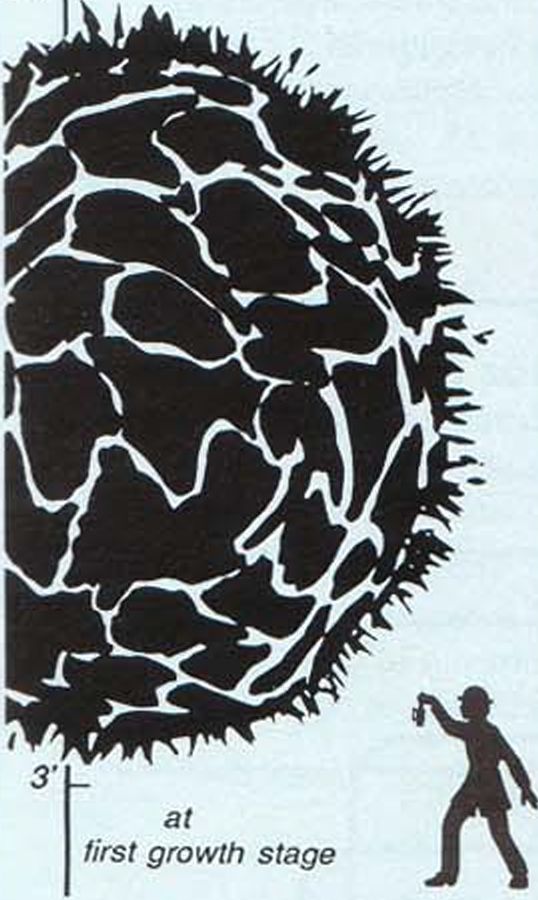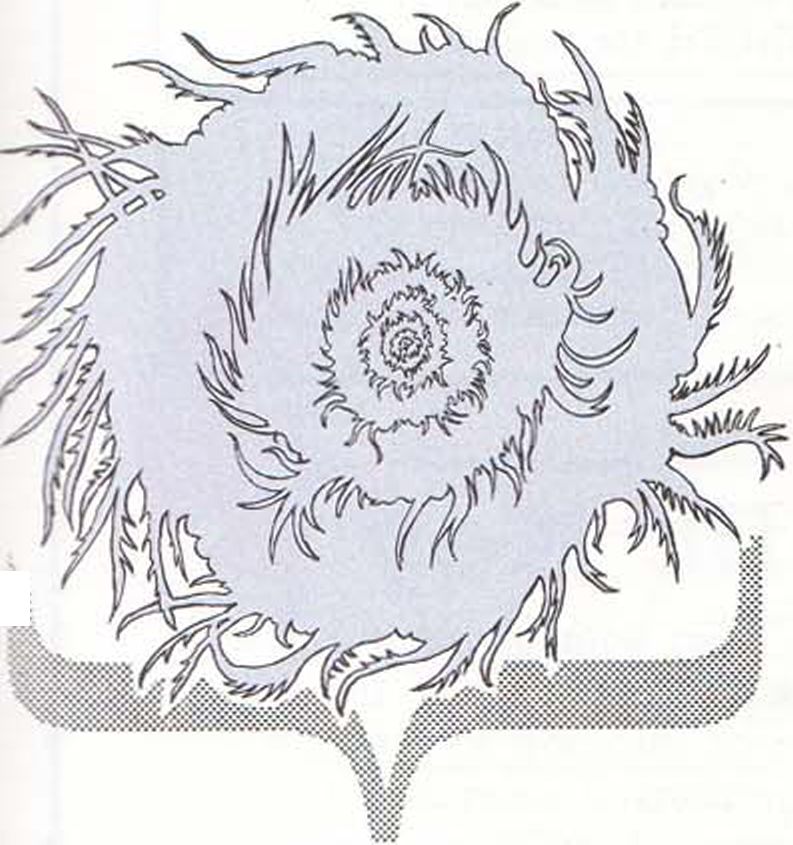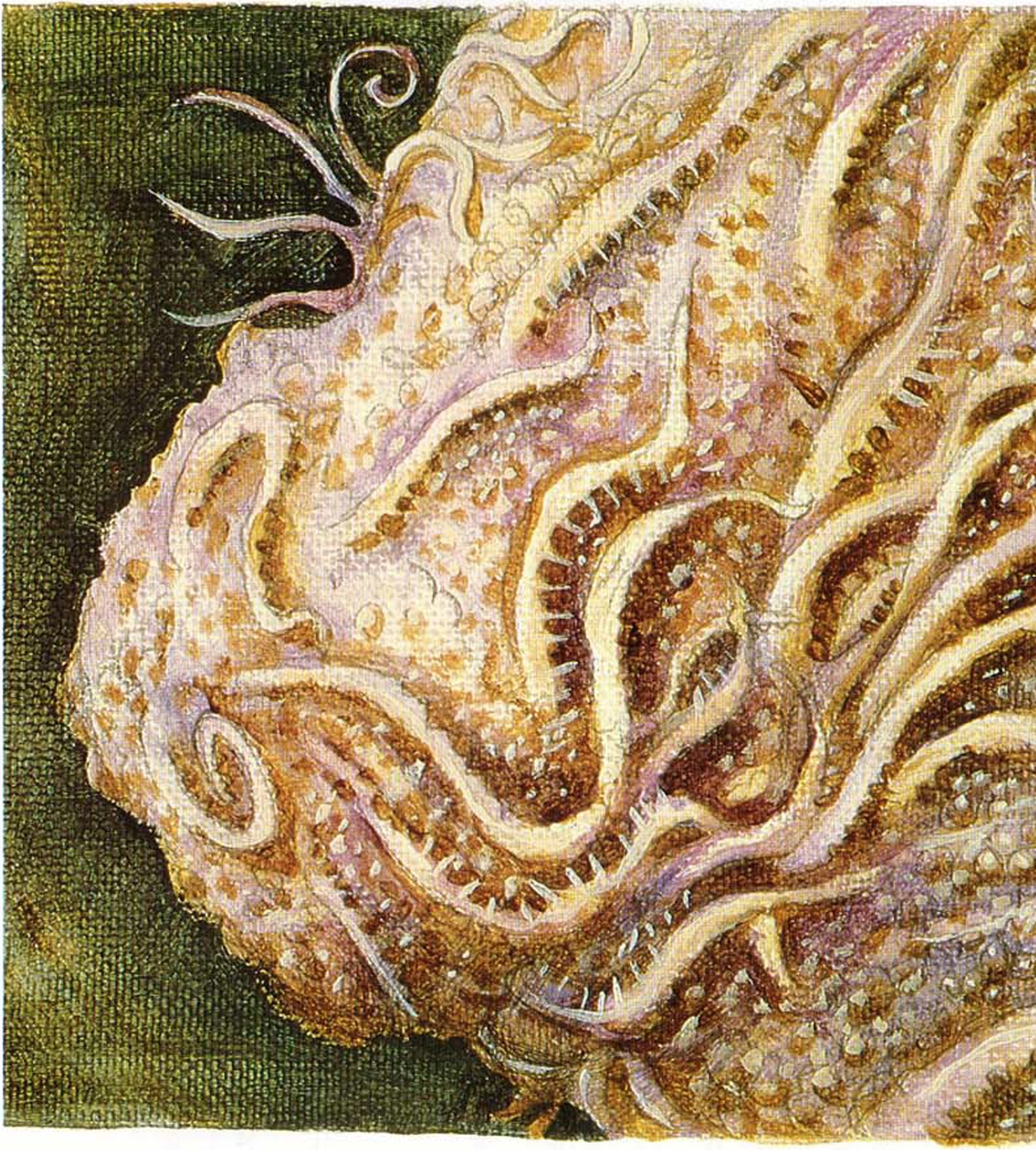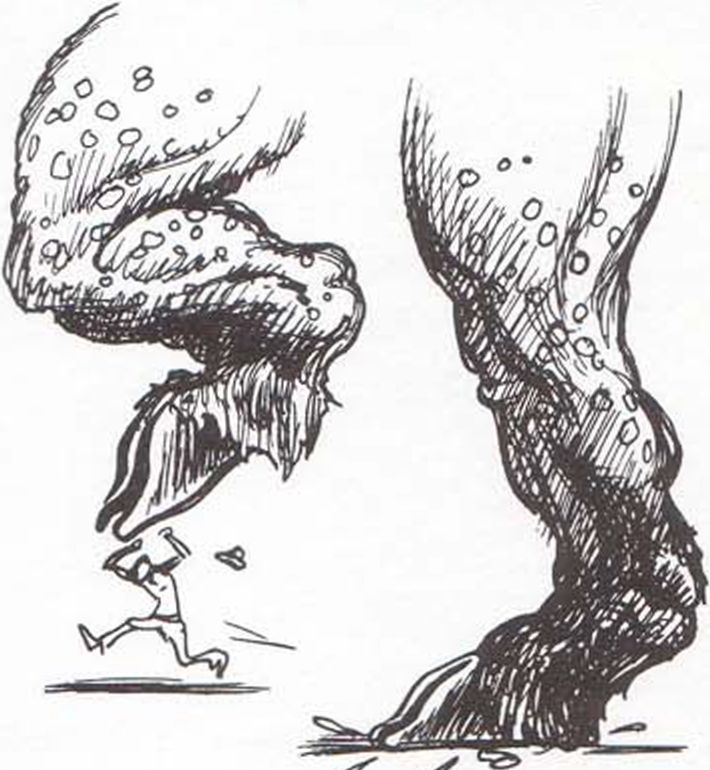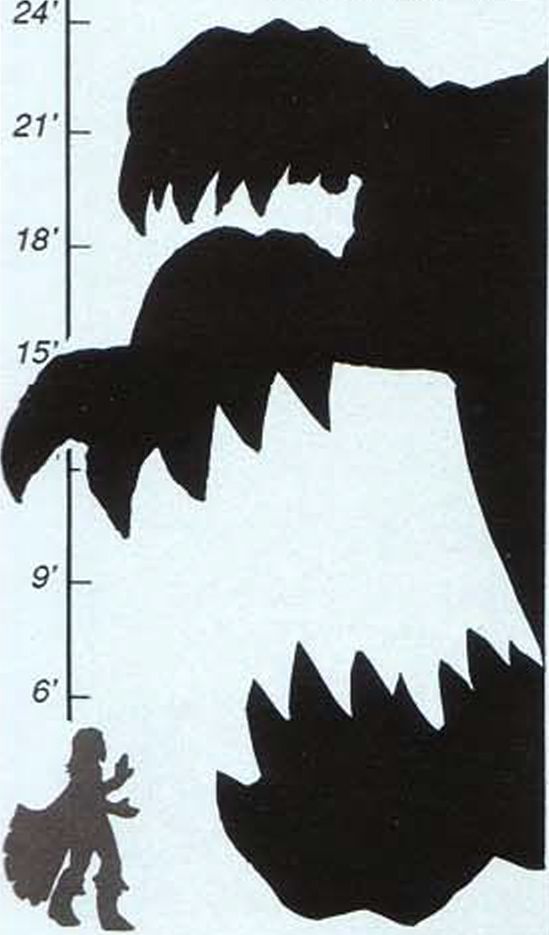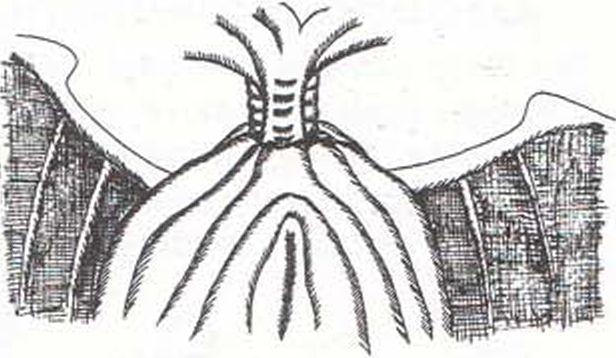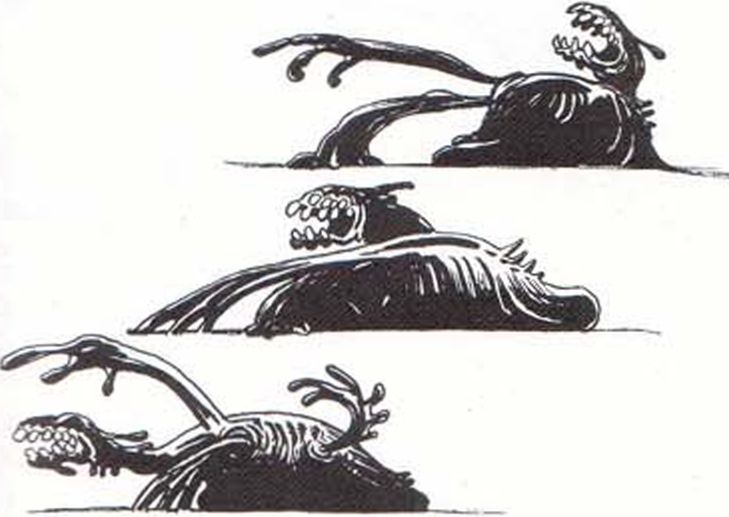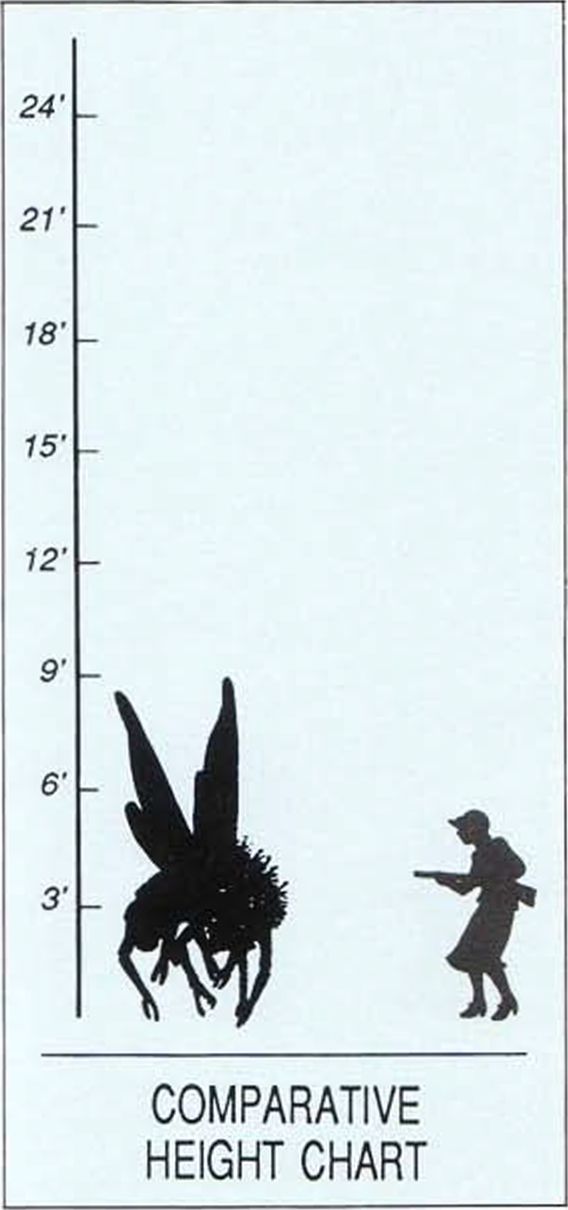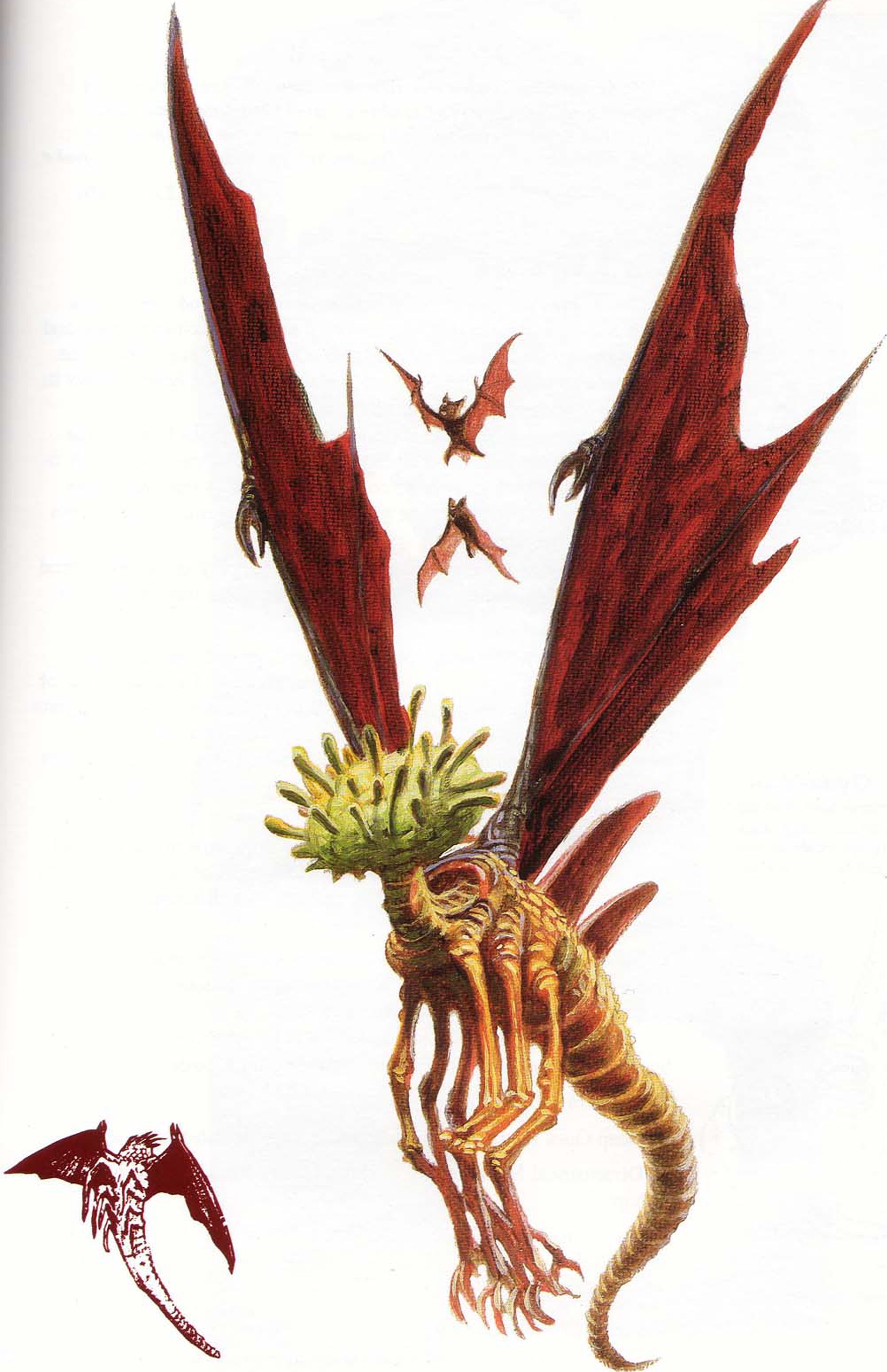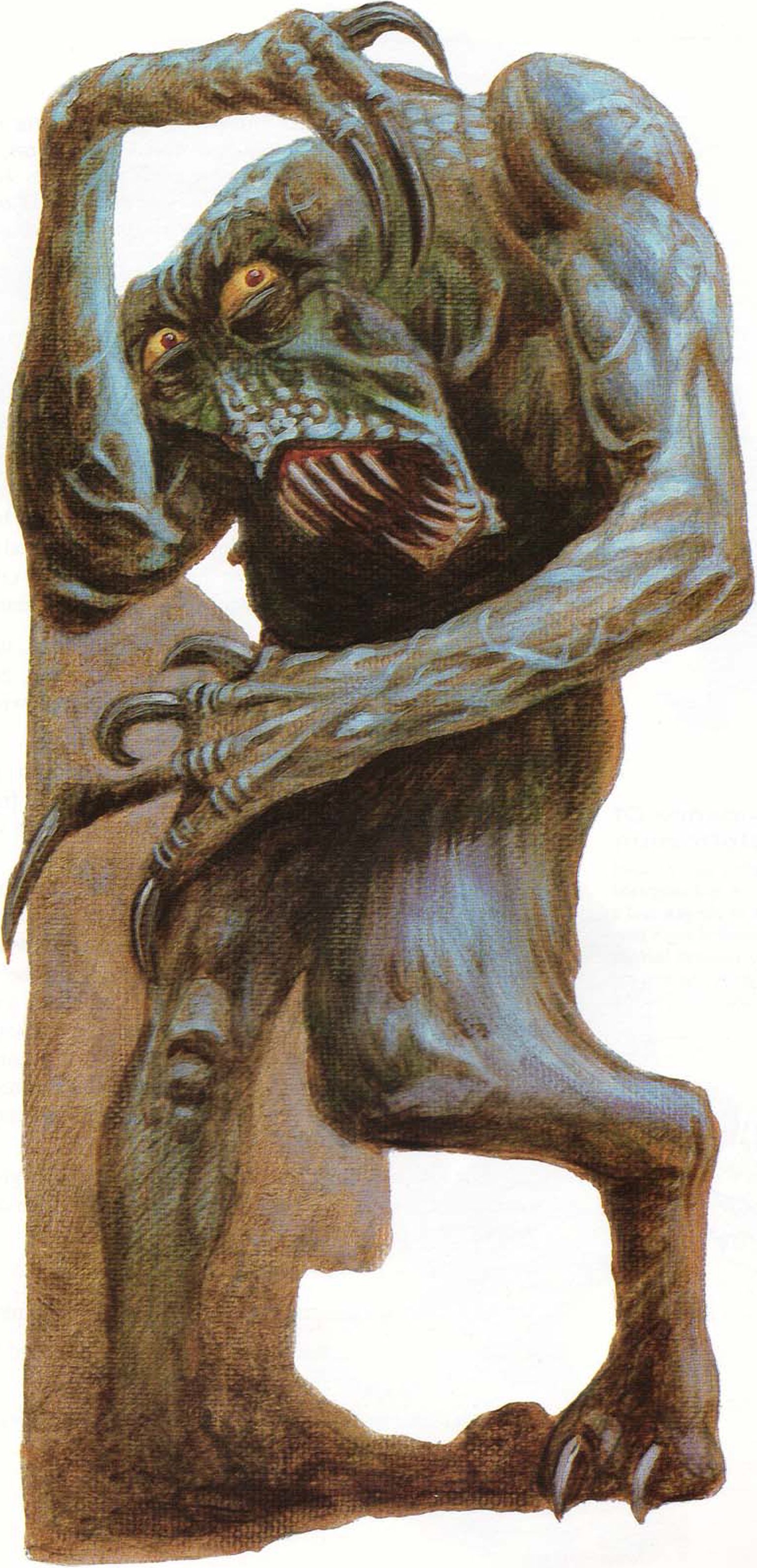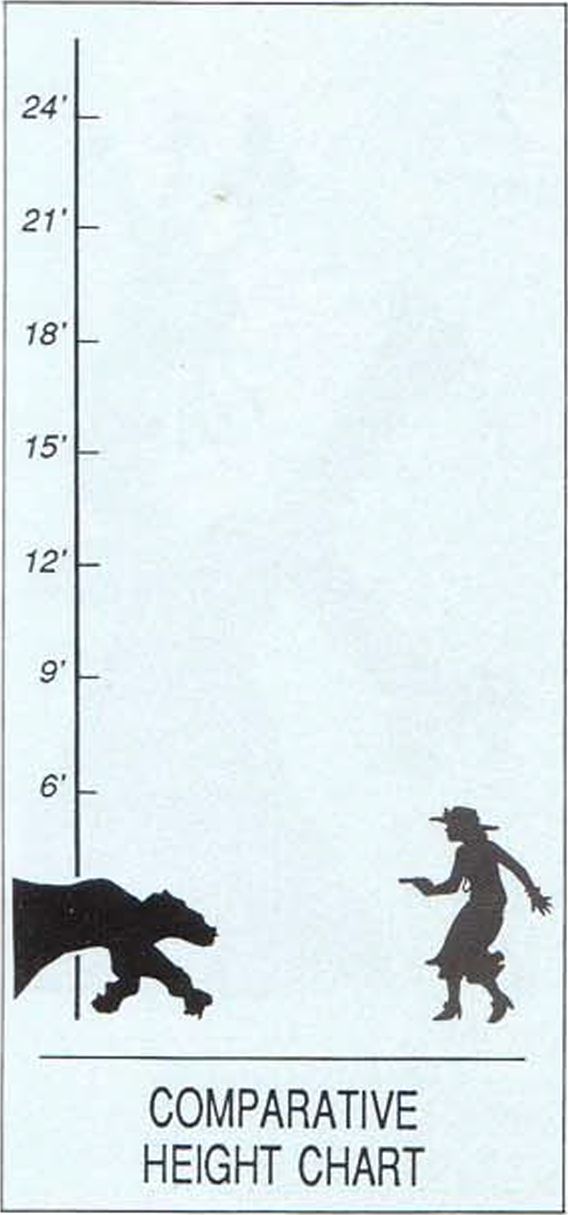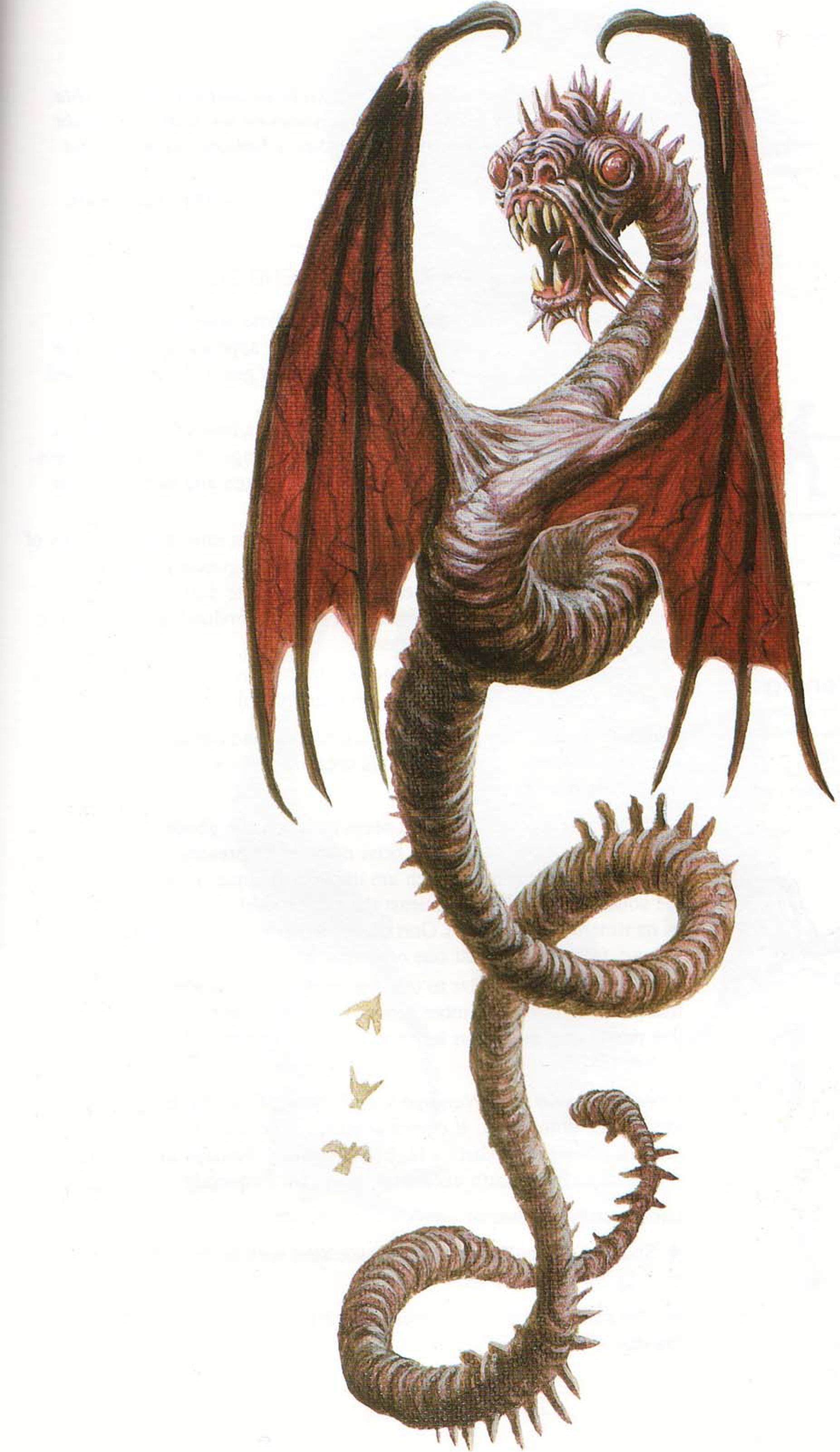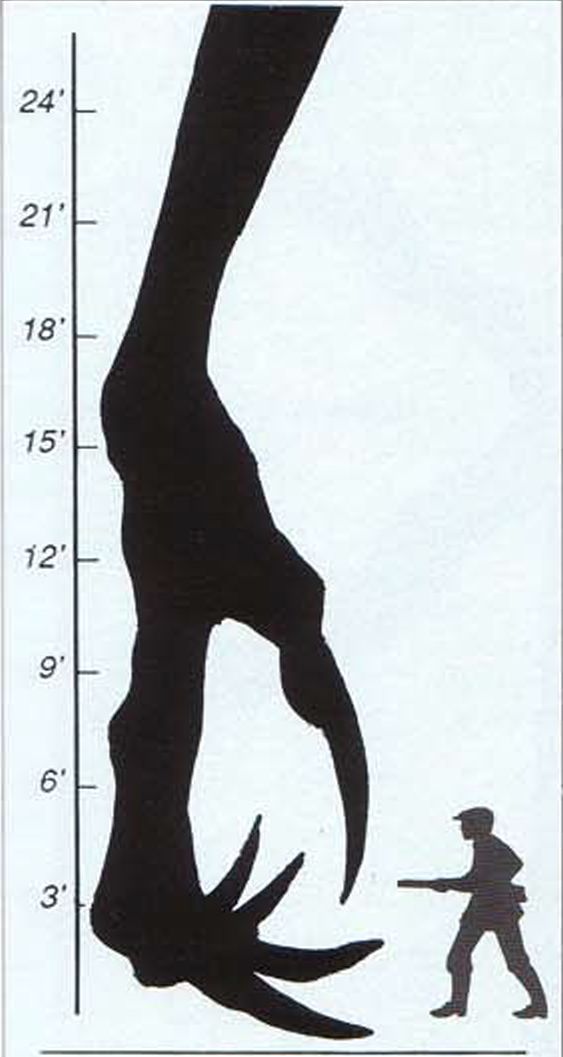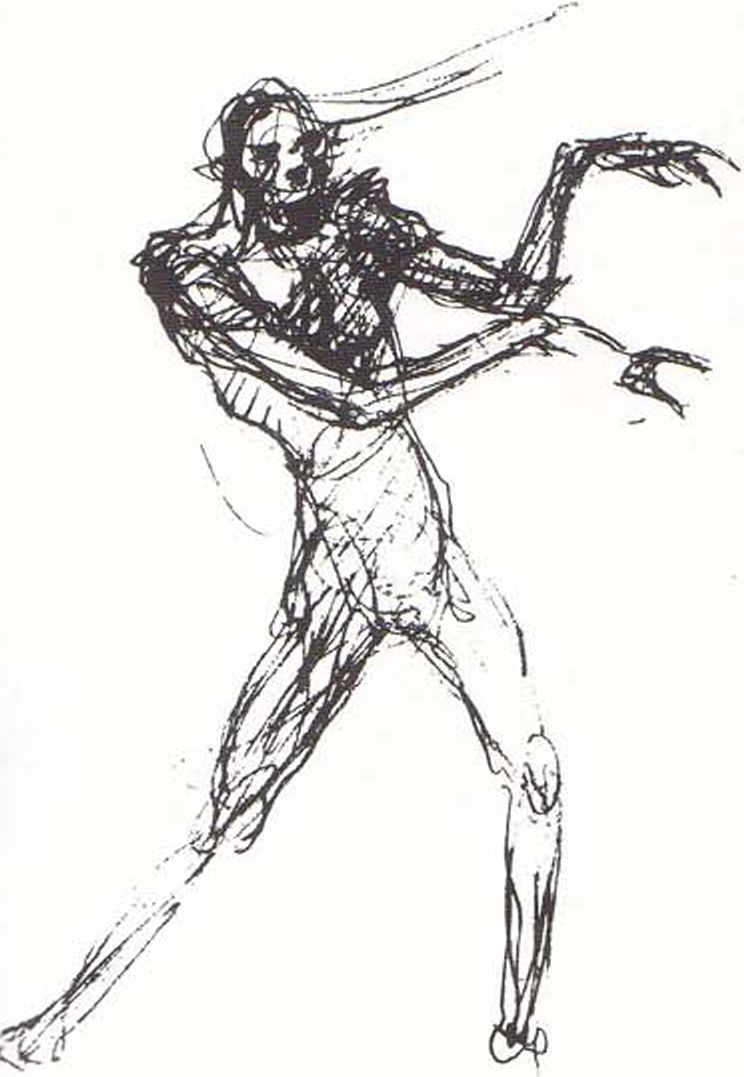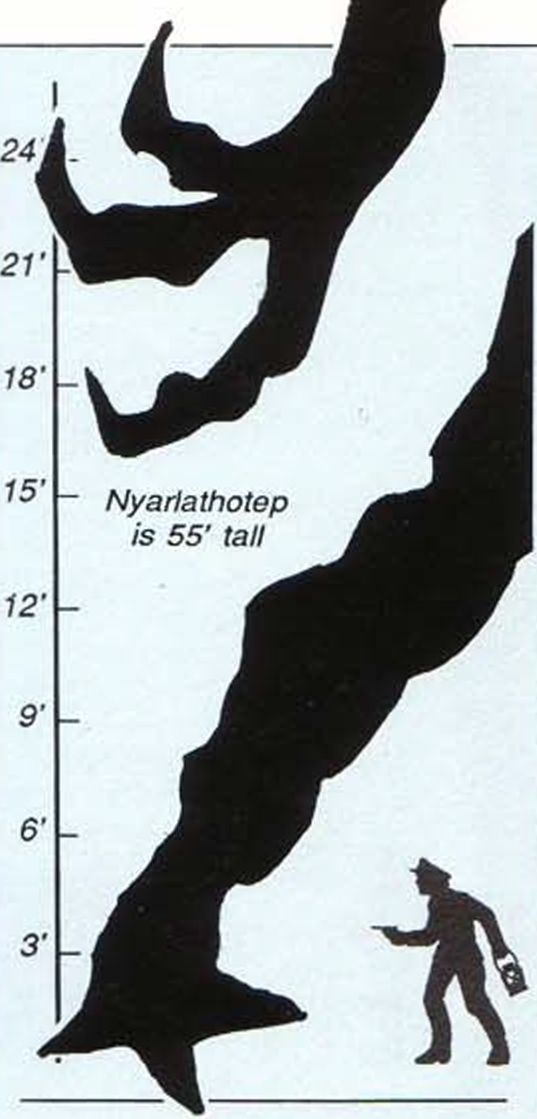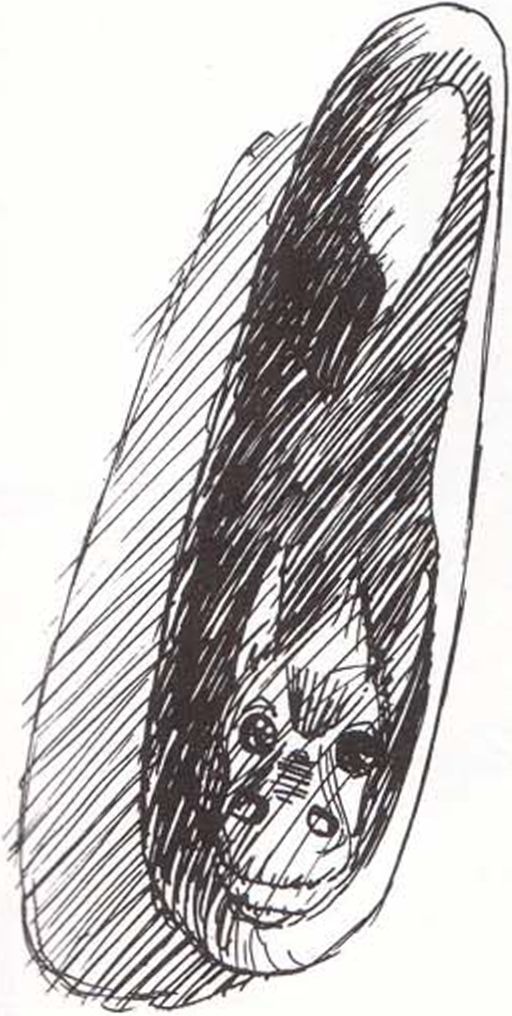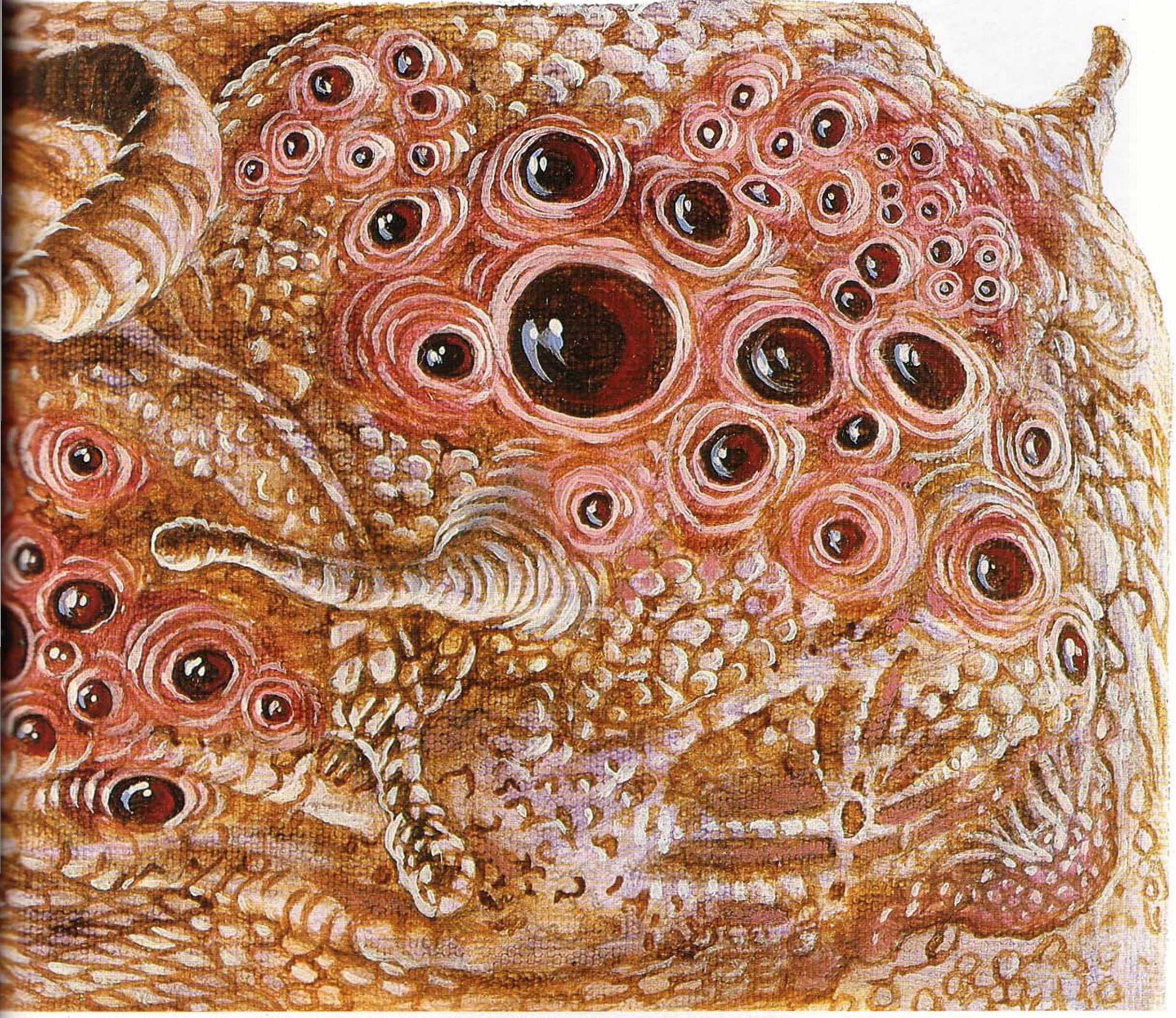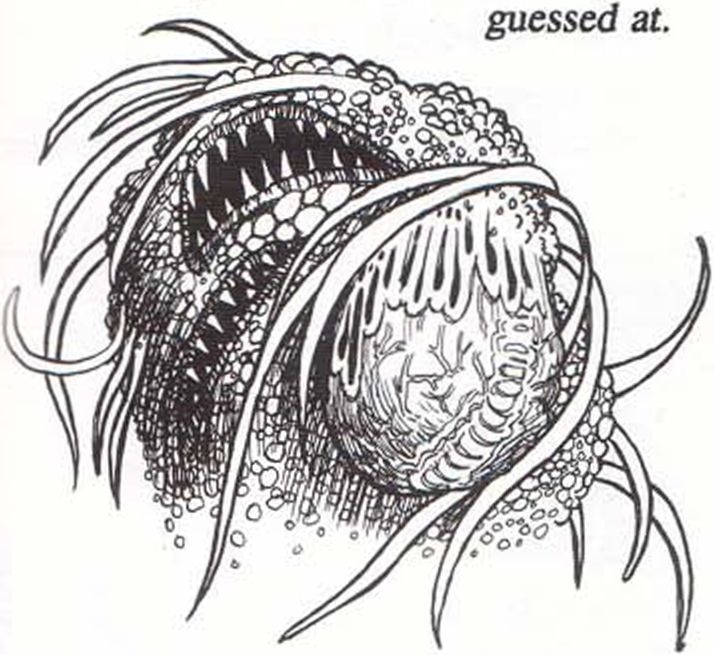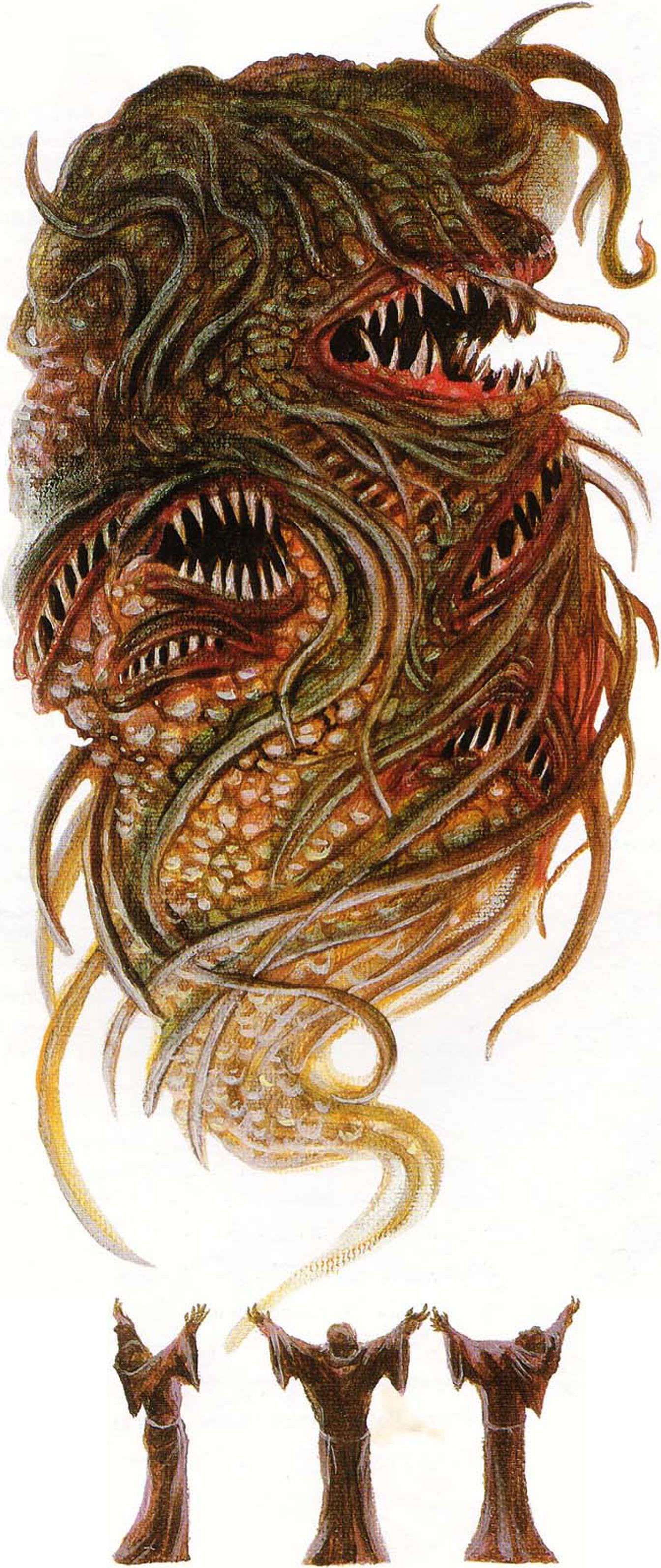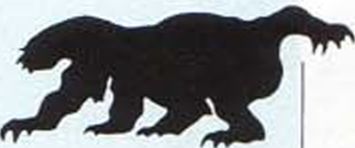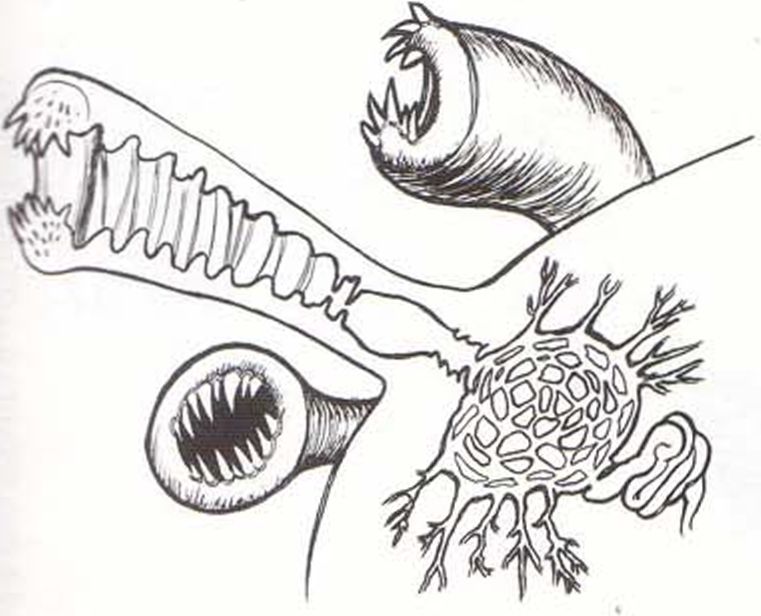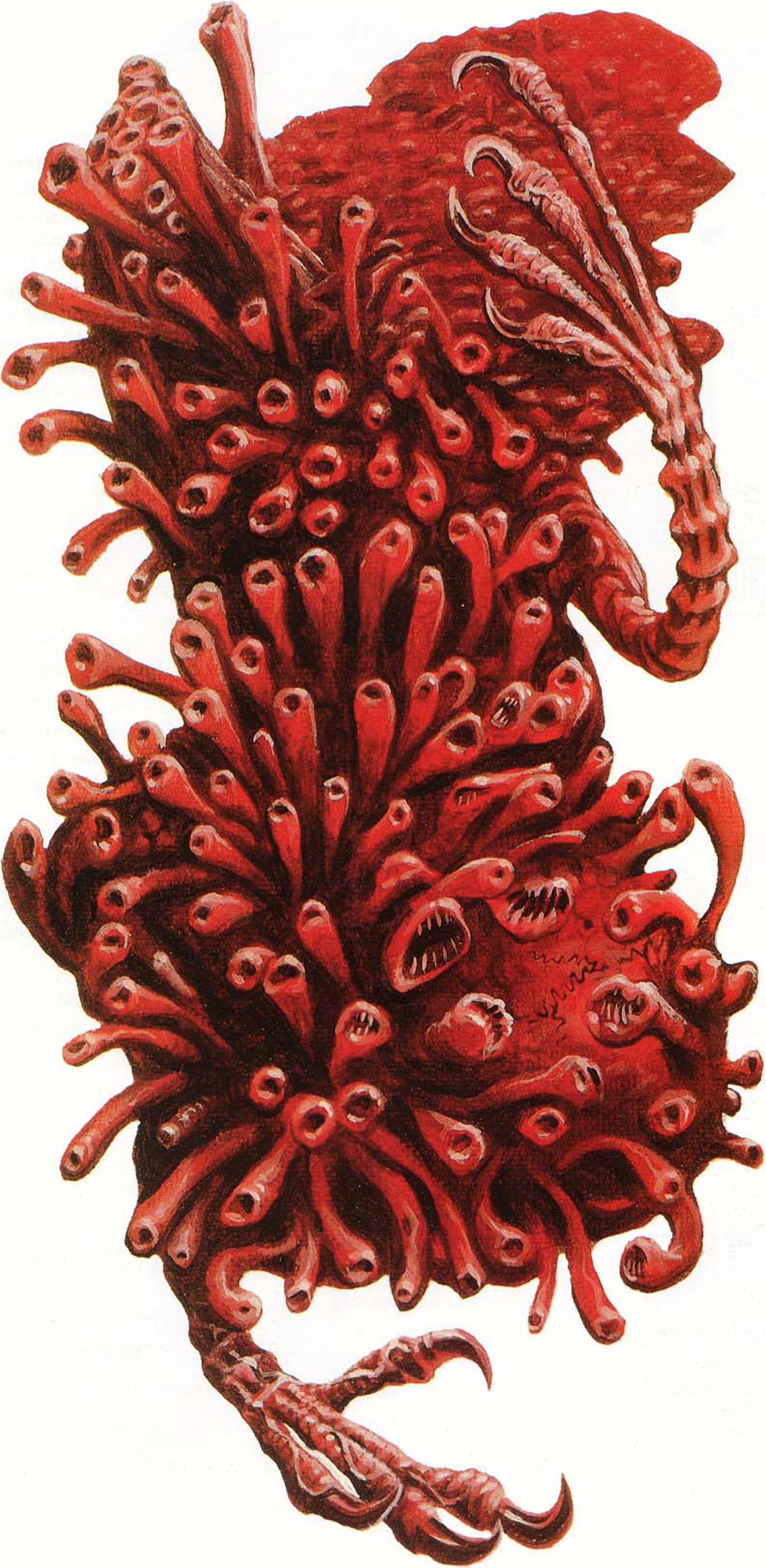Field Guide to Cthulhu Monsters - S.Petersen's 1988
INTRODUCTION
Though we now praise such studies, students of preternatural lifeforms once were castigated and persecuted. For generations, ’pracktikal metaphysiques ’ were threatened merely for striving after the truth. Those pioneers faced hair-raising danger — not only from the things they studied, but also from the hand of their fellow man.
The present volume presents information to the public in what is believed to be an easily assimilable form. All concerned hope that knowledge of these strange creatures can become more widespread, increasing support for urgently-needed research efforts.
THESE PAGES DISCUSS 27 TERRORS of the hyper-geometrical realms, those which most concern us Earth-bound mortals.
Each two-page entry has an identical apparatus: a general discussion, notes on habitat, distribution, and life and habits, and hints for distinguishing one entity from others in this book. There is a height chart, and a diagram of some special point of interest about the entity.
Since many preternatural creatures do not photograph well or cannot be photographed at all, an accurate painting illustrates each monster.
An easy-to-use scientific key helps tell one monster from another. Near the end of this field guide, a relative-size chart compares the 27 field guide monsters with the creators of this book. A bibliography and recommended reading list complete the text.
PRENATURALIST FIELD WORK IS EXCITING and personally rewarding, but amateur preternaturalists are reminded to take appropriate precautions before initiating observations.
Obstacles to successful observation are plain. With rare exceptions, preternatural collections in museums or zoological gardens do not exist, so that the student gains little acquaintance with the entities he or she seeks to encounter. Indeed, preternatural physical evidence of any sort is difficult or impossible to come by.
The naturalist can establish blinds, follow game paths, lurk near water holes, plant video cameras, and otherwise dog the heels of his chosen species. Such ploys are unavailable to the preternaturalist, whose interest may be not only off-planet but out-of-universe. And metaphysical observation methods are available only to scholars and other trained professionals. Understandably, the successful observer must be extremely patient and have a comprehensive knowledge of previous Earthly appearances.
But the thrill of seeing your first Dark Young smashing its way, say, through the Louisiana bayous cannot be duplicated.
I REMIND READERS OF SUPERB DESCRIPTIONS to be found in the writings of Howard Phillips Lovecraft; his work remains an inspiration. An intriguing game, Call of Cthulhu, discusses these monsters and others more rare. Actual investigations are more dangerous and more tedious than the fictive adventures which the game creates; still, the tone is exactly right.
GOOD SPOTTING!
— Professor-Emeritus Eliphas Cordvip Fallworth, The School of Medieval Metaphysics, Miskatonic University.
-
16. Is Its size . . .
-
• immense, over 20' tall? — ITHAQUA, see pages 42-43;
-
• moderate? —go to question 17.
29. Does the entity have a head ...
-
• tentacled and octopoid-like head, with claws and narrow wings? — SPAWN OF CTHULHU, see pages 14-15;
-
• vaguely equine, with large wings but no tentacles? —SHANTAK, see pages 52-53.
-
17. Does It have . . .
-
• a tentacled face and highly plastic form?
— MOON-BEAST, see pages 44-45;
-
• no tentacles and definite shape, and possibly manifest from nowhere? —go to question 18.
-
13. Does It have . . .
-
• horns and black skin? —NIGHTGAUNT, see pages 46-47;
-
• a pinkish, crustacean-like integument? — FUNGI FROM YUGGOTH, see pages 30-31.
-
18. Is It bipedal?
-
• yes — go to question 19;
-
• no, but usually manifesting first as smoke, then forming a body? — HOUND OF TINDALOS, see pages 38-39.
-
19. Are its hind legs . . .
-
• hypertrophied and built for leaping? — GHAST, see pages 32-33;
-
• not hypertrophied? — go to question 20.
-
20. Is Its hide . ..
-
• wrinkled and baggy? —DIMENSIONAL SHAMBLER, see pages 22-23;
-
• not baggy and lacking huge folds?
— go to question 21.
-
22. Are the body portions . . .
-
• often invisible, does the entity continually emit piping noises, and is it associated with strong winds? — FLYING POLYP, see pages 26-27;
-
• always visible, and is the entity unassociated with wind? —go to question 23.
• a basic Jorm, w B highly malleable?
-
23. Does the creature have . . .
-
• a basic form, with head, arms, and legs, though ? — go to question 24;
-
• no permanent limbs, and is it almost completely shapeless? —go to question 25.
-
24. Does the creature have . . .
-
• a vaguely octopoid head and bat-like wings, and is it of immense size? — SPAWN OF CTHULHU, see pages 14-15;
-
• a toad-like shape, and no wings? — MOON-BEAST, see pages 44-45.
-
5. is it winged?
-
• yes — HUNTING HORROR, see pages 40-41;
-
• no — go to question 6.
-
25. Is the thing’s color . . .
-
• black with no phosphorescence, and extremely fluid? — FORMLESS SPAWN, see pages 28-29;
-
• possibly fluid, but not black or, if black, phosphorescent? —go to question 26.
-
26. Does the entity have a definite mouth?
-
• yes — go to question 27;
-
• no — go to question 28.
-
6. Is it obviously tentacled?
-
• yes — CHTHONIAN, seepages 12-13;
-
• no — DHOLE, see pages 20-21.
-
9. Does It have . . .
-
• hoof-like feet, with four huge tentacles and many smaller ones? —DARK YOUNG, see pages 16-17;
-
• talon-like claws, with many tiny tentacles ending in mouths? —STAR VAMPIRE, see pages 58-59.
-
27. Is its size . . .
-
• huge, and of cloudy form? — SHUB-NIGGURATH, see pages 56-57;
-
• moderate, and of tentacled or frog-like form? — SERVITOR OF THE OUTER GODS, see pages 50-51.
• 2. Does it have eyes?
• no — go to question 13;
• yes — go to question 14.
-
28. Does it. . .
-
• continually form eyes, small tentacles, and other organs, and does it move by rolling? — SHOGGOTH, see pages 54-55;
-
• have no eyes, and normally move only by growing? —AZATHOTH, see pages 8-9.
-
14. Does it have ...
-
• radial symmetry and eyes on stalks? — ELDER THING, see pages 24-25;
-
• bilateral symmetry and no eyestalks? — BYAKHEE, see pages 10-11.
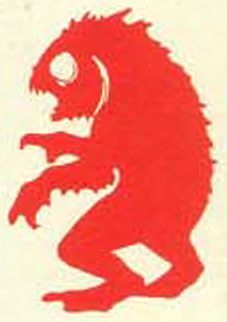
-
21. Is its hide . . .
-
• greenish and moist, does it have webbed paws, and is it an ocean-dweller? — DEEP ONE, see pages 18-19;
-
• dirty and mould-covered, and does it have half-hooved feet and a semi-canine face? — GHOUL, see pages 34-35.
and of
own
Scientific Key
INSTRUCTIONS — Start with question 1 systematically work through the list questions. Answer each question to your
satisfaction. Skip questions if instructed to do so. The capitalized name identifies your entity. Page numbers after the name allow quick reference. The key may ask questions of size, shape, etc., more than once.
-8-
24’
COMPARATIVE HEIGHT CHART
Growth Rate
This diagram shows Azathoth’s diameter after seven successive stages of growth. Each stage requires 3-10 seconds to complete.
3200 yards
Fig. 1 — Initial growth stages.
“The unknown, being likewise the unpredictable, became for our primitive forefathers a terrible and omnipotent source of boons and calamities visited upon mankind for cryptic and wholly extraterrestrial reasons, and thus clearly belonging to spheres of existence whereof we know nothing and wherein we have no part.”
— H.P. Lovecraft.
Azathoth
A seething nuclear chaos, Azathoth has existed since the beginning of time. Some theoreticians disturbingly suggest that Azathoth precipitated our universe. This entity is both blind and mindless, though of immense or perhaps infinite power.
Advanced students of hyper-dimensional geometry or hard metaphysics occasionally bring Azathoth to Earth. Usually the being manifests as an ever-changing rhythmic mass, twisting to the thin piping of tentacled Servitor attendants.
Azathoth’s presence is hazardous; always attempt to dispel the entity, for an unchecked manifestation destabilizes and grows geometrically, and can devastate large areas. Manifestations of Azathoth have reached diameters of several hundred yards to several miles across. In all known cases the entity was still growing when dispelled (Billington, 1945). The illustration to the right depicts Azathoth after approximately two minutes of growth.
One prominent line of scientific thought (Moriarty, 1872; Dannseys, 1983) argues that the asteroid belt between Mars and Jupiter was formed when Azathoth shattered the planet previously in that orbit. Given such cataclysmic potential, we emphatically recommend avoiding contact with this being.
Habitat: beyond normal space-time, at the center of the universe. Distribution: Azathoth is restricted to the center of the universe, or to where it is summoned.
Life And Habits: On its throne, Azathoth writhes unceasingly to the thin, monotonous piping of a demon-flute, as other colossal entities slowly dance round, twisting and contorting unspeakably. Presumably their continuing deformations have cosmic significance.
Distinguishing Azathoth —
-
♦ a Flying Polyp continually moves; Azathoth stays at one spot;
-
♦ a Formless Spawn is smaller and always black in color;
-
♦ a Servitor of the Outer Gods is much smaller and often wields a flute; normally at least one Servitor accompanies Azathoth;
-
♦ a Shoggoth is unaccompanied by music or by lesser beings;
-
♦ Shub-Niggurath exudes an extremely foul odor and possesses distinguishable mouths, while Azathoth has no identifiable body parts.
I
O\
I
^Oln]©™
COMPARATIVE HEIGHT CHART
“There flapped rhythmically a horde of tame, trained, hybrid winged things .... They were not altogether crows, nor moles, nor buzzards, nor ants, nor decomposed human beings, but something I cannot and must not recall.”
— H.P. Lovecraft.
Byakhee
The Byakhee is an interstellar being composed of conventional matter. The body of a Byakhee has two major portions, the thorax and opisthosoma. From the thorax stretch two wings, two limbs, and a head. Two additional manipulatory limbs grow from the forepart of the opisthosoma, while the hune, a unique paramagnetic organ, occupies much of the opisthosoma’s remainder.
It is a noisy, active entity. At rest and in flight it screeches and croaks, except when stalking prey. Though its limbs are sturdy enough, the Byakhee rarely walks, flying whenever possible.
Habitat: preferring airless planetoids and comet nuclei, a Byakhee enters atmospheres only to feed on planet-bound organisms.
Distribution: perhaps originating near Aldebaran, Byakhee can be found as far as several hundred light years from that star. They travel to Earth, but do not dwell here.
More Mystery
Though biologically unrelated, structurally the Byakhee’s hune is found where stingers are located in Earthly bees. Might the hune originally have had an attack function? Extensive data on the Byakhee is found in Treer (1984).
Life And Habits: Byakhee are encountered singly or in small groups. Their breeding habits are unknown. Byakhee generally feed on interplanetary life-forms rare to Earth’s solar system, but Byakhee also devour Earth-dwellers with bothersome regularity.
Interesting Facts: the hune as an organ is not well understood by exobiologists. It may be attuned to the galactic magnetic field, propelled by the flux. On a planet, the hune allows a Byakhee to hover; its wings must be used for movement and steering. In space, the hune allows movement and limited maneuver.
At the Earth’s surface, Byakhee can fly at 70kph, a speed increasable as air pressure lessens; in space, a Byakhee can eventually reach speeds one-tenth that of light. In interstellar vacuum, the Byakhee’s hune can generate the spacetime pattern called a keim by ancient writers. Within it, a Byakhee can travel at speeds up to 400 times that of light. Generating a keim is hard work, and only is done for interstellar voyages. The trip ended, the emerging Byakhee is voraciously hungry: avoid it. Most Byakhee encountered on Earth arrive by keim.
Distinguishing Byakhee —
-
♦ Fungi From Yuggoth are pinkish, have six manipulatory limbs, and fly clumsily in atmosphere, unlike agile Byakhee;
-
♦ Nightgaunts are black, voiceless, and faceless, and have tails;
-
♦ Shantaks are much larger than Byakhee.
BFZ
’•Sv.
24'
2V
COMPARATIVE HEIGHT CHART
Chthonian Larva
This hatchling will soon need blood. Such young Chthonians are quite vulnerable, in contrast to the hardy adults. Note the thick mineral shell within which the larva develops. Casual observers easily mistake the stone-like eggs for geologic formations.
Fig. 3 — Emerging hatchling.
. Strange life . . . may pulsate in the gulfs beyond the stars or press hideously upon our own globe in unholy dimensions which only the dead and the moonstruck can glimpse.”
— H.P. Lovecraft.
Chttionian
This large burrower’s trunk is cylindrical, tapering to a posterior point; at the anterior is a mass of tentacles. The Chthonian has no eyes. It spends its life miles beneath the Earth’s surface; if surfacing after an earthquake or an eruption, a chanting noise accompanies it.
A Chthonian can manipulate the Earth’s crust by means not understood. In concert they cause earthquakes of intensities proportionate to their numbers: thirty adult Chthonians can duplicate the force of the 1906 San Francisco earthquake.
This creature finds large quantities of water deleterious, but resists great heat: an adult can cheerfully wriggle through molten lava.
The Chthonian has powerful mental abilities and can detect, influence, and control human actions at a distance. A Chthonian rarely deals with a human as anything but as an annoyance or as food.
As a society, these inimical creatures may permit human civilization to thrive because they are so few in number that they could not destroy us before we learned to fight back. Or perhaps Chthonians encourage human “nests” (cities) because they await a major hatching, and need prey for their hordes of young.
Habitat: miles underground. Chthonians can swim deep within the mantle, possibly visiting the Earth’s core.
Distribution: global. And, as Chthonians are extra-terrestrial in origin, presumably they also infest other planets.
Life And Habits: this complex creature reaches adulthood after millennia, passing through five life-stages en route. A Chthonian larva is susceptible to heat, and must remain near the surface of the crust. A larva requires liquid organic material (such as blood) to develop; it sucks body fluids from hapless victims through its tentacles. A mature Chthonian needs less such liquid, deriving metabolic energy by traversing the thermal gradient between Earth’s mantle and upper crust.
A Chthonian is preoccupied by gathering food for, training, and protecting its larvae. Do not harm or collect hatchlings, as the adults are aggressive and vindictive.
Distinguishing Chthonians —
-
♦ Cthulhu’s Spawn often possess limbs as well as tentacles, and are octopus-shaped, not worm-like;
-
♦ Dholes are much larger and lack tentacles;
-
♦ Servitors are much smaller, have eyes, and piping flute-like sounds accompany them.
- 13 -
COMPARATIVE
HEIGHT CHART
“. . . There is no language for . . . such eldritch contradictions of all, matter, force, and cosmic order. A mountain walked or stumbled. . . . [The] spawn of the stars had awaked to claim his
own. The stars were right again.”
— H.P. Lovecraft.
Spawn Of Cthulhu
Cthulhu is the most famous of a species which came to Earth hundreds of millions of years ago. These entities are gelatinous green in color, and come in two shapes: huge octopus-like beings, or bloated entities with dragon-like wings and talons, and faces covered by barbels. Cthulhu himself is of the latter shape.
Such Spawn are extraordinarily plastic, and can rapidly and drastically change shape. Individual limbs and body members always remain identifiable, though they may be distorted, atrophied, or hypertrophied.
Habitat: Though water does them no harm, Cthulhu and his clan traditionally but incorrectly have been viewed as sea beings: they are primarily land-dwellers. Entities of great power, they can travel through space at will, plunging from world to world.
Flight
To fly, a Spawn must put most of its mass into its wings.
Distribution: these beings follow an inexplicable cosmic cycle of activity and inactivity. At the moment, almost the entire race is in suspended animation, resting until the end of the current cycle when they can live again. Evidence exists that their time is near.
Life and Habits: while sleeping, they can take only mental action, such as broadcasting dreams or telepathic instructions. Presumably, when they wake to active life, Cthulhu and his race intend to re-establish the civilization they possessed in ancient times. Most of the race appears to have lived in a single immense city which once covered much of the south Pacific. Currently they and their city, R’lyeh, are buried under thousands of feet of water and hundreds of feet of silt and stone. The breeding habits of this species are unknown, though they might reproduce by mitosis. If this surmise is true, all the million inhabitants of R’lyeh may descend from Cthulhu himself.
Distinguishing Cthulhu’s Clan —
-
♦ Chthonians have no wings or other limbs;
-
♦ Dark Young are smaller, without definite head structures;
-
♦ Flying Polyps are smaller, accompanied by whistling noises, and have temporary lapses of visibility;
-
♦ Ithaqua lacks tentacles, is restricted to cold climes, and flies without wings;
-
♦ Servitors of the Outer Gods are much smaller, lack wings, and generally travel by rolling.
Fig. 4 —Proportion of Spawn wingspan to body.
24'
21'
18'
15'
COMPARATIVE HEIGHT CHART
Leg Articulation
Though the average Dark Young has trunk and legs of about 8 feet, and an overall height of some 20-25 feet with tentacles extended, there is no maximum size for this creature. Specimens upwards of 70 feet have been encountered, and a portion of one is depicted below. Note the manner in which the leg is retracted as the creature steps forward. As the foot is lowered, it also expands laterally to take the
Dark Young’s weight.
“ Much of the power of'Western horror-lore was undoubtedly due to the hidden but often suspected presence of a hideous cult of nocturnal worshippers whose strange customs— descended from pre-Aryan and pre-agricultural times—were rooted in the most revolting fertility-rites of immemorial
" _ H.P. Lovecraft.
Dark Young
One of Shub-Niggurath’s many titles is “The Black Goat of the Woods with a Thousand Young.” The Dark Young are the ’Young’ to whom that title refers.
Typically dendroid, a Dark Young has several stout, hoof-like legs supporting a thick body marred by gaping maws dripping goo. The body is topped by a maze of variously-sized tentacles, always including four large tentacles as thick as tree trunks.
Habitat: a Dark Young is most often encountered in densely overgrown regions such as forests and swamps, presumably where its shape allows it the best cover for hunting. A limited survey (Isinwyll, 1986) suggests that Dark Young tend most often to be found in temperate and sub-tropical climates on Earth.
Distribution: encountered world-wide, especially where the Shub-Niggurath cult persists. Dark Young presumably originate on one or more alien worlds; none has been proved native to Earth. This creature does not naturally live here for longer than a few years at a time.
Life and Habits: though intelligent, the Dark Young most often is found alone. It feeds on the body fluids and internal organs of luckless living beings who wander into range of its powerful tentacles.
Ordinarily (Isinwyll, 1987), the Dark Young waits motionless for prey, then, having fed, moves quickly to another location to repeat the pattern. Several cases exist of Dark Young tracking and pursuing victims: perhaps these Dark Young were particularly hungry or under powerful compulsion.
The Dark Young does not reproduce on Earth, and nothing is known of its breeding habits, if any. Possibly all are produced by Shub-Niggurath and have no need or ability to reproduce. This seems unlikely, in view of the emerging record (Isinwyll, 1981) of Dark Young participation in human prehistoric fertility rituals; mythic power is traditionally attributed to forests and trees; the Tree of Life, The Tree That Walked, etc., are important symbols.
Distinguishing Dark Young —
-
♦ Chthonians are legless;
-
♦ The Spawn Of Cthulhu are larger, and possess heads;
-
♦ Shub-Niggurath is larger and has a much less definite form.
- 17 _
The ’Innsmouth Look’
Progressive degeneration caused by the Deep One genetic taint. At age 34, this man is nearly ready for The Change. His skin is peeling, and his ears have been resorbed.
Soon his nose will drop off.
. They hopped irregularly, sometimes on two legs and sometimes on four .... Their croaking, baying voices . . . held all the dark shades of expression which their staring faces lacked.” __
— H.P. Lovecraft.
Deep One
A Deep One is an ocean-dwelling being which vaguely resembles a hybrid of fish and frog. It has gills, but can also breathe air, and can survive on land indefinitely. The Deep One is usually a bluish-green color with a pale belly. On land, a Deep One may walk on four limbs or on its hind legs only. It swims with webbed, flipper-like paws. It emits a nauseating fishy stench.
When a Deep One mates with a non-Deep One, the hybrid offspring at first resembles an ordinary member of the non-Deep One species. With time, it degenerates, internally and externally drawing closer to a full Deep One. Eventually the offspring undergoes the Change, and (if land-dwelling) returns to the sea to take its place in undersea society. Deep Ones are known to have bred successfully with humans and dolphins, though the metamorphosis takes longer in dolphins, probably because the bone structures are dissimilar.
Not all Deep One hybrids complete metamorphosis. Slight variations in environment or heredity greatly affect the process.
No Deep One dies naturally. The longer it lives, the larger it grows, and it can become exceptionally large. Conversely, a starving Deep One shrinks, metabolizing muscle and bone tissue. Prolonged starvation can reduce a Deep One to frog-size. Several weeks of heavy feeding are needed to regain normal mass (d’Erlette, 1959).
Habitat: undersea, especially the continental shelves at depths less than a kilometer, in temperate and tropical climates.
Distribution: in every ocean, and along the coasts of most continents. The Deep One is apparently native to Earth, though its evolution remains obscure.
Life And Habits: This carnivorous aquatic vertebrate is intelligent and boasts a civilization. It lives in undersea cities, herds schools of fish, and engages in sophisticated manipulations of selected local human populations. Given a uniquely malleable chromosomic pattern, it routinely participates in successful reproduction with different species.
Distinguishing Deep Ones —
-
♦ Dimensional Shambiers are proportioned quite differently, with much longer arms and loose, wrinkled hides;
-
♦ Ghasts move with hopping motions, and never go on all fours;
-
♦ Ghouls emit odors of mold and old soil;
-
♦ extremely large Deep Ones crudely resemble Ithaqua, but Ithaqua is always accompanied by freezing cold, and lacks fins or gills.

this Dhole is about 800' long
COMPARATIVE HEIGHT CHART
Dhole Mouth-Parts
These mouth-parts are normally kept retracted within the forebody, as in (A) below. They can be quickly extended when needed (B).
Fig. 8a — Dhole mouth closed.
“The true weird tale has something more than secret murder, bloody bones, or a sheeted form clanking chains according to rule. A certain atmosphere of breathless and unexplainable dread of outer, unknown forces must be present; and there must be a hint, expressed with a seriousness and portentousness becoming its subject, of that most terrible conception of the human brain — a malign and particular suspension or defeat of those fixed laws of Nature which are our only safeguard against the assaults of chaos and the daemons of unplumbed space.” Lovecraft
Dhole
A Dhole is a colossal worm-like organism found on certain distant worlds. A light-avoider, this burrower is rarely seen. The Dhole can squirt a noxious acid slime from its mouth.
The most remarkable feature about a Dhole is its enormous size, typically at least 600 feet long and 20 feet thick. A Dhole 1000 feet long and 50 feet thick is not unusual. While this creature can expand and contract its body in much the same manner as an earthworm, the Dhole is not a shape-changer in the manner of Cthulhu’s star-spawn or the Moon-Beasts.
Habitat: deep underground. The Dhole never frequents the surface of a world until it has riddled and ruined the interior of the crust. A riddled crust is like a sponge, with Dhole tunnels extending in every direction, a terrifying labyrinth.
Distribution: no Dhole has been found on Earth, though that does not mean that a few are not present. Since they are known to inhabit several planets, they must have access to some means of interstellar travel. Perhaps other beings transport them.
Life And Habits: a scavenger, the Dhole feeds on hydrocarbons (fresh or decayed) of every type, including coal, oil, dirt, corpses, etc. With its huge size and persistent tunneling, such a monster scours an infested planet of life. Any encounter with a Dhole on Earth should be reported at once to the proper authorities.
The Dhole life-cycle is little-studied. One theory (Marsh, 1980) conjectures that the Dhole is actually the final stage of Chthonian development, though most exobiologists reject this approach. A likelier hypothesis (Dannseys, 1981) is that the creature originates in a plane of existence commonly known as the Dreamlands. This theory argues that the colossal Dreamlands entities known as Bholes give birth to Dholes, dropping them through the interdimensional fabric onto hapless worlds. This would explain how these unintelligent creatures spread from world to world.
Distinguishing Dholes —
♦ Chthonians have tentacles, and are much smaller.
-21 -
“. . . Its rugose, dead-eyed rudiment of a head swayed drunkenly from side to side. Its forepaws were extended, with talons spread wide, and its whole body was taut with murderous malignity despite its utter lack of facial description.”
— H.P. Lovecraft.
Dimensional
Shambier
This shaggy, wrinkled entity inhabits transcosmic eddies outside our universe. A Dimensional Shambier has large claws, a shapeless face with empty eyes, and a loose-hanging hide. Yog-Sothoth and other creatures are known to inhabit the same transcosmic realm, but none are so well-known to us as the Shambier, which habitually enters our physical universe.
No one knows how this predator selects its prey. One hypothesis (Larkhan, 1985) suggests a pattern derived from matrix mechanics in which the trigger variable is the performance of three fundamental human activities in a specific sequence. Much research remains to be done, however.
Forepaw Articulation
The fingers on each end of the hand structure are reversed, to serve as thumbs. All fingers can be so reversed at will, swiveling 180° on sturdy basal socket-joints. The Shambier can choose among 32 hand configurations when grasping for or manipulating objects.
Fig. 7 — A Shambier digital arrangement.
Habitat: between dimensions. The Dimensional Shambier continually traverses the planes, emerging to feed or engage in rituals, then returning to its native non-continuum. No record of the Shambier’s transcosmic environment exists.
Distribution: interdimensional. The Shambier is everywhere and nowhere; its actual numbers are unknown. If summonings are ignored, estimates of yearly incidence on Earth range from a high of 8500 to zero (Wilbham, 1988).
Life And Habits: the Dimensional Shambier is a solitary hunter possessing a natural ability to enter the fourth and higher dimensions, thereby obtaining food, escaping foes, and traveling swiftly.
It can dimly peer between the dimensions and spy on lesser beings with ease. Its favorite hunting ploy is to materialize inside a closed structure, avoiding outside observation and insuring that its chosen prey cannot easily escape.
Reproduction, life span, social life, etc., must remain unknown until investigators find some way to pierce the transcosmic veil.
Distinguishing Dimensional Shambiers —
-
♦ Deep Ones generally sport smooth or scaled skin;
-
♦ Ghasts are more active, and possess clearly defined faces;
-
♦ Ghouls have human proportions and run on their toes;
-
♦ Hounds Of Tindalos first manifest as clouds of smoke and, once formed, are easy to distinguish from Sham biers.
-23 -
misuwiHig iwrasiNsiM
“The toughness of the things was almost incredible. Even the terrific pressure of the deepest sea bottoms appeared powerless to harm them. Very few seemed to die at all except by violence, and their burial places were very limited.” _ R p Lovecraft
Elder Thing
PAINTING ABOVE — The Elder Thing is contracted into the common rest position, concealing its neck and stalk within torso cavities.
An Elder Thing, or Old One, is a crinoid-like, half-vegetable organism with a star-shaped head, an erect barrel-like body, a multiplicity of tentacles, and five wings. When not in use, the wings are pulled into little pockets in the sides of the thick torso. This species is notable for its strong radial symmetry.
The Elder Thing civilization prospered on Earth for millions of years. Its last land stronghold was in Antarctica; with the advent of the last ice age, it was forced entirely undersea. Over the course of that civilization, the species became progressively more decadent, losing most of its ancient lore. Now its range is entirely submarine, confined to the deepest parts of the
ocean.
Arriving on Earth over a billion years ago, the race survived the interstellar journey by means of a chemical process which rendered them
Vertical Adjustment
An Elder Thing can alter its height by extending its neck and/or stalk. In 9a., below, the extended neck reveals a set of gill slits. Note also the beginnings of a wing pocket in the torso, directly below the neck. In 9b., the stalk is clearly shown. Extension of the stalk frequently indicates interest or excitement, or is done in preparation for flight. In flight, an Elder Thing usually extends both neck and stalk, as
impervious to temperature fluctuation, vacuum, and any need to eat or breath. On Earth the species created simple organisms as food, as well as shoggoths to serve as slave-beasts. Either as accident or joke, the Elder Things also prompted the development of all earthly life.
Habitat: the deep sea. These creatures inhabited a wide variety of terrains; conceivably one might be found anywhere.
Distribution: along the mid-Atlantic ridge. Eons ago, the Elder Thing was found across the entire southern hemisphere (later, only Antarctica). These intelligences originally came to Earth from another world. Closely-related species are known to still thrive on distant planets.
Life And Habits: An Elder Thing reproduces through spores. It can derive nourishment from inorganic substances, but is much more active and vigorous when feeding on organic life, especially animals. The Elder Thing is extremely tough, can survive all ordinary temperatures, and can move with great speed on land, sea, and air.
The ill-fated Starkweather-Moore expedition emphasized the once-high aesthetic and intellectual development of the species.
Distinguishing Elder Things —
-
♦ Fungi From Yuggoth have rounded heads, only two wings, and are never found underwater.
shown by the silhouette on the facing page.
Fig. 9a —Neck extended.
COMPARATIVE HEIGHT CHART
Ground Movement
The Polyp extrudes five-toed limbs to support itself or to move without flying. Though it can fly, this creature often strolls considerable distances on the ground.
Fig. 10 — Limb extension.
“ They were only partly material [and] had the power of aerial motion, despite the absence of wings .... There were . . . suggestions of a monstrous plasticity and of temporary lapses of visibility . . . . ”
— H.P. Lovecraft.
Flying Polyp
We may characterize the Flying Polyp by its irregular lapses into invisibility and by its monstrous plasticity of form. A Flying Polyp also emits a continual piping whistle, which fixes its approximate location even when this malevolent being is invisible.
The race of Flying Polyps originally descended from space to prey upon early Earth life, building windowless cities of dark basalt towers. Eventually they were warred on and defeated by the Great Race, who forced the Polyps underground. There the Polyps grew strong and numerous, and eventually they preferred that environment to the surface. Occasionally, the Polyps surge up from below, but have been quiescent in humanity’s time.
Great Race research shows that the Polyps will become extinct on Earth sometime after humanity’s own demise.
Habitat: in the Paleozoic era, the Flying Polyp lived and thrived on the surface world. Currently it is found only in underground caverns: presumably surface conditions have changed so much that the species now prefers subterranean life.
Distribution: large underground caverns all over the world. The Polyp does not inhabit most caverns known to humanity, since the hapless discoverers of Polyp abodes rarely manage to report their finds. The Flying Polyp originated somewhere in the stars; relatives probably still exist there.
Life And Habits: the Flying Polyp feeds horribly upon any organism it can hunt down, using great winds in hunting and in warfare. Polyp presence, in fact, can easily be ascertained by unusual wind behavior — winds that suck instead of blow, winds that snake around obstacles instead of being blocked by them, and similar unusual effects.
The spoor of a Flying Polyp is five circular toe-marks, easily distinguishable from those of almost any other organism.
Distinguishing Flying Polyps —
-
♦ Flying Polyps can be recognized by continuous lapses into invisibility, a feature shared by few other organisms;
-
♦ Star Vampires make tittering or laughing sounds, quite dissimilar to the Flying Polyp’s eerie whistles;
-
♦ Servitor pipings have insane phrasings, without intelligence or insinuation, and Servitors do not extrude legs nor do they fly;
-
♦ Formless Spawn are black in color.

aw EWAldJ
24'
21'
18'
15'
12'
9'
COMPARATIVE HEIGHT CHART
Locomotion
Appendages on the being’s upper surface pull it forward; as it moves, fresh appendages sprout from behind. The diagram does not convey the thing’s speed — over 20mph for extended distances.
“. . . They found living things [that] worshipped onyx and basalt images of Tsathogghua. But they were not toads like Tsathogghua himself Far worse — they were amorphous lumps of viscous black slime that took temporary shape for various purposes. The explorers of K’n-Yan did not pause for detailed observations, and . . . sealed the passage.”
— H.P. Lovecraft.
Formless Spawn
This organism is associated with the worship of the entity known as Tsathoggua. A Formless Spawn is a fluid black entity which can change shape with lightning rapidity, sprouting legs, teeth, heads, eyes, and wings, making temporary shapes for temporary needs.
Though their stone artifacts reveal human-level intelligence, no direct communication ever has been achieved with these implacable beings. And, since Formless Spawn are immune to ordinary physical weapons, investigators have been reluctant to expose themselves to extended contact with these strange creatures.
Habitat: primarily underground. They build stone channels along which they ooze their viscous bodies with great rapidity. Evidence so far indicates (Wasling, 1984) that their zone of habitation is strictly crustal, perhaps even limited to limestone and other organic deposits.
Distribution: Formless Spawn dominate the lightless cavern of N’Kai, and probably inhabit other cave systems as well. Since it is unknown whether or not this species evolved on Earth, there may or may not be Formless Spawn on other planets.
Life And Habits: the Formless Spawn feeds on a wide variety of substances. Primarily it metabolizes organic debris, but also devours living animals, plants, and fungi when available.
Little is known of Spawn reproduction or lifespan, though fistsized calcite structures uncovered at N’Kai (Dannseys, 1987) may hold some answers, if geneticists can decode their structures.
Distinguishing Formless Spawn —
-
♦ Azathoth is much larger and always is accompanied by secondary beings;
-
♦ Flying Polyps normally vary between visibility and invisibility, and often leave the ground for brief flights;
-
♦ Moon-Beasts are pale, not black;
-
♦ Servitors of the Outer Gods produce demonic piping music, while Formless Spawn are generally silent;
-
♦ Shoggoths move by rolling or oozing, rather than quickly forming and reforming legs.

Fungi Technology
The ultimate purpose of this cylinder is unclear. It contained a living human brain when discovered in northern Canada. Note the three plug-ins around the center grill.
Fig. 12 —Brain storage cylinder.
. Crustaceous bodies bearing vast pairs of dorsal fins or membraneous wings and several sets of articulate limbs, and with a sort of convoluted ellipsoid, covered with multitudes of very short antennae, where a head would ordinarily be.”
— H.P. Lovecraft.
Fungi FROM Yuggoth
A pinkish fungoid crustacean-like organism with wide, often fan-like wings, it typically has six main limbs and a featureless wrinkled head which can alter color. It can fly, but in Earth’s atmosphere does so clumsily and slowly. A Fungi speaks by rapidly changing the colors of its head. To talk long-distance, it projects varicolored beams of light.
Many Fungi species exist, lacking wings or possessing different body features; all seem to work together amicably. The type illustrated here is the sole variety to visit Earth in any numbers. None are actually fungi. That is a traditional term adopted from the early work of Prof. Fallworth, of Miskatonic University.
Selectively consulting with and employing humans, Fungi miners thereby avoid unwonted contact and maintaining secure operations.
Habitat: Fungi science allows settlement anywhere. Nothing is known of any original habitat.
Distribution: in the Mesozoic era, Fungi From Yuggoth invaded and colonized Earth’s northern hemisphere. Later they abandoned most of those settlements. Fungi are found today in a few remote locations on Earth, including the Himalayas, Appalachians, and Andes.
Apart from Earth, these creatures have a vast interstellar empire of planets, dark stars, and less describable objects. Yuggoth (Pluto) is the major Fungi base nearest to their Earthly enterprises.
Life And Habits: a Fungi is not composed of ordinary terrene matter. Prolonged effort generates extraordinary metamorphoses and transmutations, creating or deleting organs or body members. This, rather than ordinary evolution, may explain the Fungi’s various forms. Their voice-box organ was evolved for use on Earth, enabling Fungi to approximate human languages in weird, buzzing tones.
These starfarers coexist in dimensions additional to our own four. Most Fungi visiting Earth have membraneous wings for pressing against a medium non-existent to us but which, omnipresent on a different plane, enables them to fly through space.
Distinguishing Fungi From Yuggoth —
-
♦ Byakhee fly well, and have four major limbs and definite faces;
-
♦ Elder Things have more than two wings;
-
♦ Nightgaunts are black, not pinkish;
-
♦ a Star Vampire may look pinkish while feeding, but has no wings and becomes invisible as it digests.
Sketch at lower left, opposite page: an alternate view of a Fungi.
. Something about the size of a small horse hopped out into the grey twilight, [a] scabrous and unwholesome beast, whose face [was] curiously human despite the absence of a nose, a forehead, and other important particulars . . . [it] spoke in coughing gutterals.” _ HJ>. Lovecraft
Ghast
To human eyes perhaps the most repulsive underground life-form, a Ghast is a great floundering whitish thing with a black-furred back and a distinct trace of human ancestry in its noseless, bulging-lipped face. It moves by leaping on its long hind legs. A flashlight beam annoys it; it cannot long survive in direct sunlight.
Two important species of Ghasts are known, those living in the Vaults of Zin and the domesticated variety found in the cavern of K’n-yan. This latter species is more commonly known as the gyaa-yothn (singular, gyaa-yoth). Only the gyaa-yothn possess rudimentary horns centered in their foreheads.
All varieties are very agile, leaping and hopping on powerful hind legs, and easily jumping chasms several times wider than possible to any human.
Gyaa-Yoth
Note the prominent horn, and the subdued mouth and fangs. Ears and infrared receptors are shown behind and below the eyes.
Fig. 13 — Another species of Ghast.
Habitat: deep underground. Sunlight kills it, though the Ghast can indefinitely survive red light or twilight conditions. The gyaa-yothn of K’n-yan resist blue light as well. One theorist (Isinwyll, 1985) suggests that the gyaa-yothn differentiated when subjected to a specific otherworld environment; exploratory dissection (Mustoll, 1985) shows increased musculature and rearranged internal organs congruent with that idea.
Distribution: solely underground. The blue-litten caverns of K’n-yan are found underneath the American Great Plains. The caverns of Yoth, beneath which sit the Vaults of Zin, are also in North America, but their precise location is unclear.
Life And Habits: the Ghast is omnivorous, feeding primarily on fungus. This uncouth being relishes flesh when available, and frequently resorts to cannibalism.
Most Ghasts have a crude language. The gyaa-yothn have had bred out of them what little intelligence they once possessed.
Distinguishing Ghasts —
-
♦ Deep Ones are rubbery-skinned, with frog- or fish-like appearances;
-
♦ Dimensional Shambiers have short, twisted hind legs and never leap or hop;
-
♦ Ghouls resemble Ghasts at a distance, but Ghasts leap much further and higher.
Most Ghasts are lighter in color than the one shown on the opposing page.
Evidence Of Transformation
Transformation into a Ghoul includes elongation and increased musculature of the jaw and a flattened, extended brain pan. Human-derived features include complete eyesockets and the persistence of true cheekbones.
“It was a .. . nameless blasphemy with glaring red eyes, and it held in bony claws a thing that had been a man, gnawing at the head as a child nibbles at a stick of candy. Its position was a kind of crouch, and as one looked one felt that at any moment it might drop its present prey and seek a juicier morsel.”
— H.P. Lovecraft.
Ghoul
Not completely human, though it often approaches human likeness, the Ghoul is roughly bipedal, with a slouching, vaguely canine aspect, which includes a rubbery hide, pointed ears, a mould-caked body, half-hooved feet, and scaled claws used for burrowing.
Habitat: the Ghoul primarily dwells in an individual burrow or a larger multi-individual underground complex. It is nocturnal. Owing to its feeding preference, this creature thrives near human cities, especially near cemeteries, hospitals, schools, and shopping centers.
Distribution: worldwide. Except in the Dreamlands, no extraterrestrial or extraplanar Ghoul settlements are known to exist. Several commentators believe that Ghouls cannot be found where humans are not found (Gillman, 1984).
Life And Habits: a Ghoul primarily feeds on carrion. It is perfectly able to eat fresher fare, however, and often enjoys a fresh dinner as a change of pace, ripping and tearing at its unfortunate victim with powerful teeth and claws.
Unusually, the Ghoul seems to develop from a human or to require a human ancestor. Probably the Ghoul is not a separate species. Early research (Fallworth, 1927) has shown that powerful human proclivities can be environmentally enhanced, but the underlaying genetic mechanisms are not understood. Sometimes a Ghoul warren kidnaps and raises a human baby as a Ghoul. Occasionally a likeminded human adult associates with Ghouls and eventually transforms into one of them. Ghoul physiology may include a moral fetor or venom which gradually causes or aids human transformation into monsterhood (Dannseys, 1986).
The Ghoul is difficult to study or even to find, given its high intelligence and extraordinarily complete knowledge of human society, activity, and psychology.
Distinguishing Ghouls —
-
♦ Deep Ones are generally found near water and emit fishy stinks;
-
♦ Dimensional Shambiers are slow-moving, rumpled-looking beings with indistinct facial features;
-
♦ Ghasts leap on large hind legs and do not have snouts.
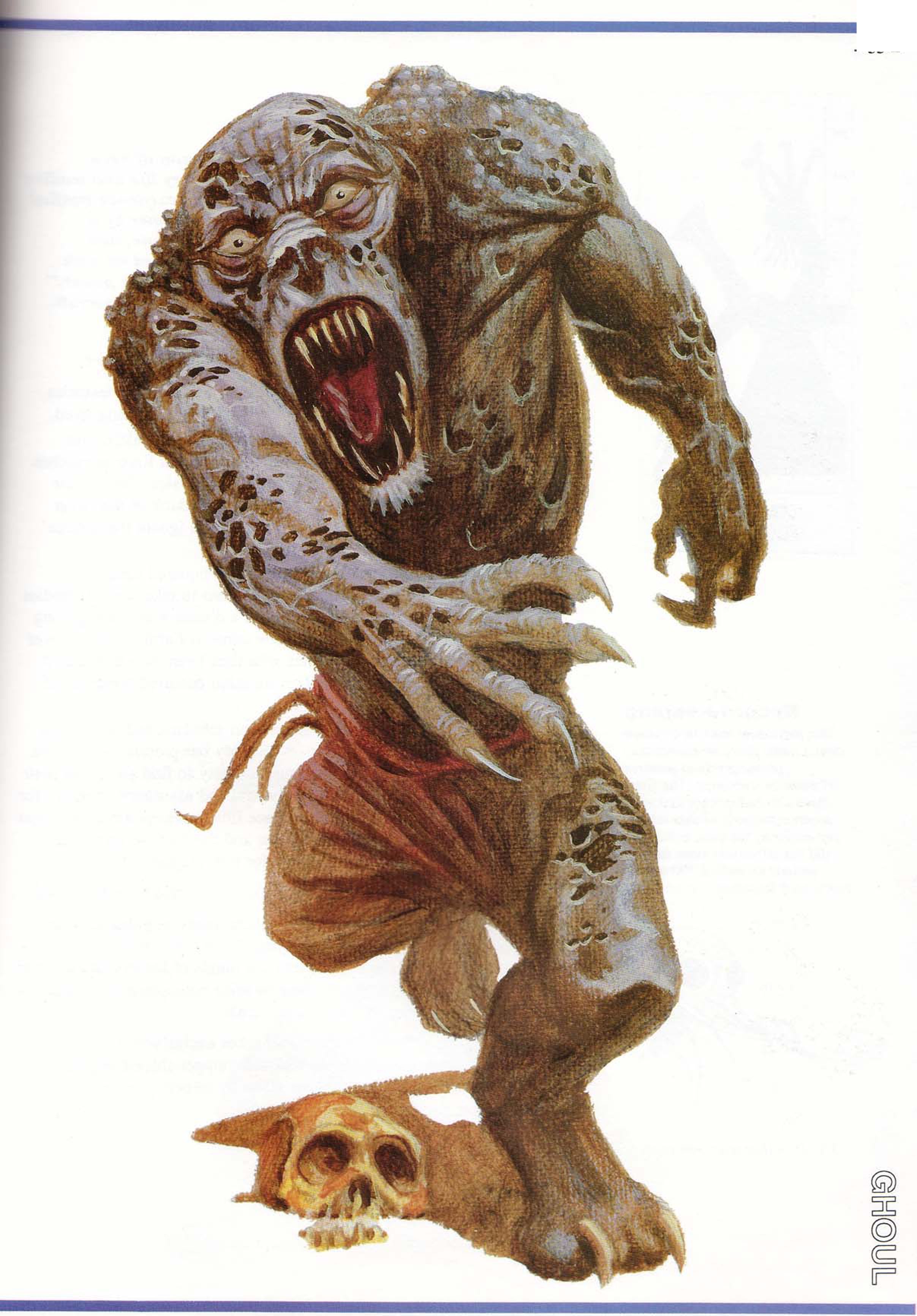
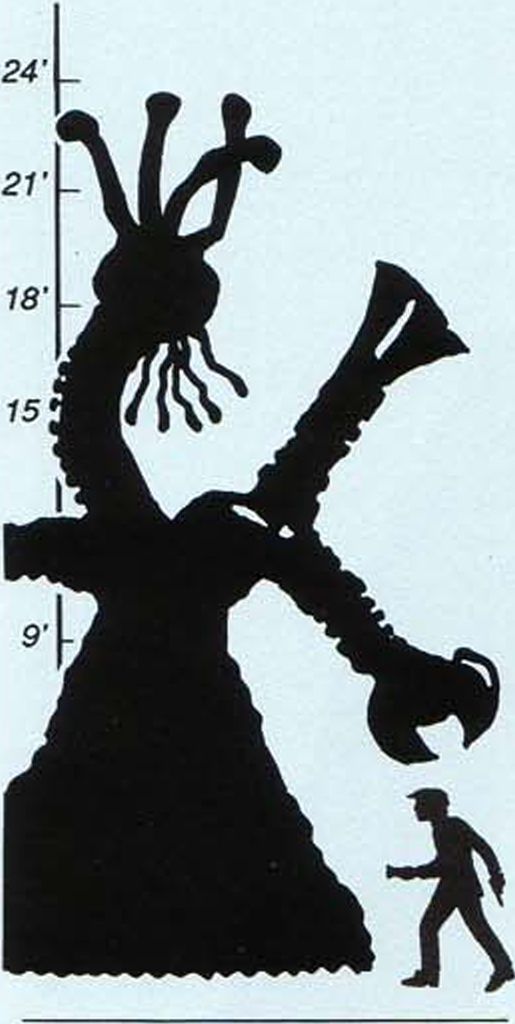
COMPARATIVE HEIGHT CHART
Record-Keeping
This individual sears information onto a metal plate, an aesthetically pleasing way to preserve information over eons. The Great Race also had quicker and more accurate methods of data storage and retrieval, but these techniques did not effectively store data for periods exceeding 100 million years; such information is now lost.
Fig. 15 — Heat-stylus manipulation.
“The essence was always the same — a person of keen thoughtfulness seized with a strange secondary life and leading for a greater or lesser period an utterly alien existence typified at first by vocal and bodily awkwardness, and later by a wholesale acquisition of scientific, historic, artistic, and anthropological knowledge; an acquisition carried on with feverish zest and with a wholly abnormal absorptive power.”
— H.P. Lovecraft.
Great Race OF YITH
This creature has a large conical body topped by four long tentacles ending in a variety of useful organs. It is intelligent and long-lived.
The human discoverer of the Great Race (Peaslee, 1936) has discussed at length systematic and long-ranged Great Race researches into natural history, psychology, and temporal physics. Given their intellectualism and moderation, the reader might think of the Great Race as so many placid monks, were he or she to ignore the species’ genocidal invasions and ferocious Earthly wars.
The Great Race is so-named because it conquered time. It developed the ability to send minds across eons to take over the bodies of other beings. The species originated on a distant world, emigrating when that world faced destruction. They came to Earth by taking over the bodies of ancient conical entities who then lived on Earth and of whom we know almost nothing. This invasion occurred hundreds of millions of years ago.
The Great Race are great scientists and scholars, and sometimes exchange minds with chosen humans to study our present-day culture. They have formed a small cult among humanity to find and assist their time-traveling scholars; the cultists give aid and assistance in return for technology or wisdom. These Great Race time-travelers are also sought by a ruthless sect connected with Hastur and the Yellow Sign, which captures researchers and tortures them for information.
Habitat: all non-arctic climates, but tropical preferred over temperate.
Distribution: the Great Race became extinct many millions of years ago, wiped out by an incursion of Flying Polyps, q.v. Before this catastrophe, however, the species sent the minds of leaders and selected scientists into the distant future, there to seize coleopteran intelligences which follow humanity in the geologic scale.
Life and Habits: a Great Race member takes exclusively liquid nourishment, feeding through the four red trumpet-shaped organs on its hinder tentacle. It breeds in shallow water by releasing spores from the edge of its great snail-like foot.
Distinguishing a Member of the Great Race —
♦ its conical shape makes it unmistakable.
The glossus is long, cylindrical, hollow, and reinforced with a
bone-like substance. The pointed tip of the glossus is thrust into a victim, and the vital essence drained through it.
. No one need wonder at the existence of a literature of cosmic fear. It has always existed, and always will exist; and no better evidence of its tenacious vigour can be cited than the impulse which now and then drives writers of totally opposite leanings to try their hands at it in isolated tales, as if to discharge from their minds certain phantasmal shapes which would otherwise haunt them.” “ “ ,
— H.P. Lovecraft.
Hound Of Tindalos
A Hound Of Tindalos is a horrendous quadruped which manifests itself through the comer angles of rooms in Earthly structures, sending itself through time and space to attack the being on which it wishes to feed. A typical Hound has a long, sinuous tongue and drips a putrid substance like blue pus.
Frankly, the Hound Of Tindalos is beyond normal human comprehension and evaluation. Though it appears so, a Hound is not an organic creature. It is a manifestation of the principle of perceptive being known to humans as “foulness.” Foulness is a hyper-geometrical organizational axis shared by many of the entities described in this handbook; as a concept, foulness is uncomfortably difficult to summarize, because as humans we identify states of being as definitional elements rather than as polyclusters.
But, following Isinwyll (1987), we are not the poorer in merely nominating the Hound as a singularity of loathsomeness and terrifying hunger, considering what humanity would be like if our understanding of the Hound was more precise, more empathetic!
Habitat: the angles of time in the extremely distant past; inconclusive evidence of pre-galactic existence has been advanced (Hike, 1983).
Distribution: the distant past. But a Hound can visit any time and almost any place, if impelled by hunger or other malign purpose.
Life And Habits: some psychic factor or inherent trait within humans and certain other life-forms appeals to a Hound, from which it gets evident nourishment. If this unknown factor is not necessary to the Hound’s survival, the species may not be truly predacious.
A Hound Of Tindalos can manifest only through an angle of 90’ or less. Whether this angle is formed by a room’s comer, a crack in a rock formation, or a bent leaf is immaterial. A Hound’s appearance is signified by clouds of vapor steaming from the chosen angle, swiftly followed by the coalescence of the Hound.
Nothing of the Hound’s life cycle, if it has one, is known, nor have significant physical evidences been accumulated from the several dozen recorded attacks (Wasling, 1982).
Distinguishing Hounds Of Tindalos —
♦ Dimensional Shambiers do not necessarily form from comers, and are bipedal.
“Beyond and above them, and dwarfing them to insignificance, was a master’s vision of the terror that stalks about and within us, and the worm that writhes and slavers in the hideously close abyss.” _ H p
Hunting Horror
This intelligent ropy being flies on webbed wings, the long length of the creature pulsating and swelling in throbbing waves. Some Hunting Horrors have two wings; others have only one, which they rotate peculiarly to keep themselves aloft. Every Hunting Horror beats its wings slowly and rhythmically, and always can be identified by a constantly writhing body and dangling head.
A Hunting Horror is not composed of ordinary matter. It co-exists on another plane coterminous with ours, as does a Fungi From Yuggoth. The Hunting Horror is able to fly and keep its huge coiling body aloft by the pressure its wings exert on the media constant to this other plane.
A Hunting Horror can speak in human tongues, though its voice is distinctively loud and harsh. The Outer Gods or Great Old Ones, especially Nyarlathotep, often use Hunting Horrors to pursue a victim.
The Head of a Horror
Most of the pits, ridges, and tissue whorls in this drawing depict sensory organs. The barbels on each side of its snout, for instance, detect air currents, enabling the predator to find a victim by the slight pressure variations caused by its breathing. Other organs sense heat, light and color, electrical conductivity, odor, and mass.
Fig. 17 — Hunting Horror close-up.
Habitat: desolate alien worlds. A Hunting Horror is only found on Earth when pursuing a quarry here, or when summoned here by individuals using hyper-geometrical or other techniques of hard metaphysics.
Distribution: though native only to a few scattered worlds, the Hunting Horror ranges through several galaxies; it may be accidentally encountered almost anywhere.
Life And Habits: in its natural state, the Hunting Horror lives on a dark planet. It cannot endure extremely bright light, or even normal daylight for more than a few hours, so it generally visits Earth after nightfall. Given the continuous solar light of interplanetary space, disagreement exists as to whether or not a Hunting Horror actually flies there; a summary of positions has been published (Gillman, 1986).
A Hunting Horror is an extremely intelligent entity which apparently functions without social organization or material civilization. Dannseys (1987) believes that a Horror’s knowledge of occult science is so profound as to render technology and informationexchange superfluous, but a controversy rages here: Varson (1988) insists that evidence of an elaborate telestitial network exists, though attempts to reproduce his data have been unsuccessful, owing to the difficulties of researching living Hunting Horrors. Hard metaphysicians perennially face this disagreeable situation.
Distinguishing Hunting Horrors —
♦ Shantaks have shorter, squatter bodies, and also have hind legs.
-41 -
COMPARATIVE
HEIGHT CHART
A Wendigo
This sketch was made by a trapper in northern Quebec who managed to evade a wendigo. Traces of the thing’s human origins are clear, but the overall change is profound.
Fig. 18—A survivor’s sketch.
. inconceivable abnormalities slyly hinted into a horrible half-knowledge by words whose innocence we scarcely doubt till the cracked tension of the speaker’s hollow voice bids us fear . . .
— H.P. Lovecraft.
Ithaqua
THE WENDIGO
The Wendigo’s howl is unmistakable, and those who hear it do not forget it. This huge, roughly humanoid being appears to walk on the winds. It is found only in the far North and is generally accompanied by freezing sleet or blizzards.
While Ithaqua is sometimes found alone, a host of lesser beings often accompany it. Included among its entourage are hapless humans who are discarded after a time, to be found frozen and half-buried in the tundra.
Ithaqua is able to transform lesser life-forms into lesser versions of itself, to serve it as scouts, companions, or in unguessable ways. In humans, this transformation leads to the complete destruction of the feet, immunity to freezing temperatures, and unendurable cannibalistic tendencies which bring on madness.
The title wendigo or windigo is Algonquian in origin, originally a term for a human which Ithaqua has transformed.
Habitat: outer space, frozen ice-flats, tundra, and alpine terrain. Earth, even the arctic, is warmer than this creature prefers, so it does not dwell here permanently.
Distribution: Antarctica would seem an amenable abode for the Wendigo, but no reports have been made of its presence in the southern hemisphere, for reasons which are unclear. Ithaqua travels throughout the solar system, visiting at least the colder worlds. It may spend much of its time in our system’s Oort cloud, whence comets originate. Ithaqua frequents at least one other star system.
Other beings similar to this one probably inhabit the galaxy; Ithaqua may be one member of an extremely powerful species, each one possessing enormous territories of one or more solar systems (Hike, 1983).
Life And Habits: the Wendigo spends most of its time traveling through its dominions. It comes to Earth more often than would seem natural, considering Earth’s high temperature. Perhaps the toothsome prey available on Earth encourage it to visit frequently.
Distinguishing Ithaqua —
-
♦ Spawn Of Cthulhu are rarely associated with arctic climates and fly only by means of wings;
-
♦ abnormally large Deep Ones never fly and are always found near the sea.

W©W1
“The moon was a crescent shining larger and larger . . . [the galley’s] destination was that secret and mysterious side which is always turned away . . . [Carter] did not like the size and shape of the ruins which crumbled here and there. The dead temples on the mountains were so placed that they could have glorified no suitable or wholesome gods, and in the symmetries of the broken columns there seemed to be some dark and inner meaning which did not invite solution.”
— H.P. Lovecraft.
Moon-Beast
Typically, this is a large, grayish-white, oily being which can contract and expand its body volume. A Moon-Beast’s general shape is toadlike. Though it lacks visible sense organs other than a quivering cluster of short, usually pink tentacles on the tip of the snout, the creature’s high intelligence and utter ruthlessness compensate for the handicap.
In the Dreamlands, the Moon-Beast culture trades extensively for sentient slaves, both as food and as labor. Their slaves hail from all comers of the known universe, though Lunar proximity makes humans the slaves of choice for most Moon-Beast buyers.
Habitat: a Moon-Beast can tolerate a wide variety of climates and conditions, and can draw upon a considerable body of technical knowledge with which to further extend its range. Colonies of Moon-Beasts might be found almost anywhere.
A Man From Leng
These humanoids have been Moon-Beast slaves and servants for many centuries, and are indelibly associated with them. The Men From Leng are confined to Earth’s Dreamlands.
Fig. 19 — General appearance.
Distribution: it seems not to be known on Earth, but infests the Moon in that cerebral dimension commonly known as the Dreamlands.
The Moon-Beast may be found only in the Dreamlands, or psychic traces of the species may still linger on the Moon in this plane, or Moon-Beast colonies simply may have expanded more rapidly in the Dreamlands than in our plane (Fallworth, 1922; Kylton, 1979). Analysis of Apollo 11 photographs leaves the tantalizing possibility that a Moon-Beast colony does in fact lay on the far side of the Moon, hidden from day-to-day human detection (Dannseys, 1971).
Life And Habits: a Moon-Beast apparently feeds solely on still-living beings, extracting a peculiar and sinister nourishment from the body and soul of the creature it devours.
The species also engages heavily in recreational torture, taking vile pleasure in the anguish of other beings. This Moon-Beast trait is so consistent that it may evidence direct mental or physical benefit from such activity.
Distinguishing Moon-Beasts —
-
♦ Formless Spawn are black;
-
♦ Servitors of the Outer Gods are even more formless than Moon-Beasts, and normally have only tentacles for limbs.
The painting on the opposing page portrays an unusually large Moon-Beast.
-45-
. They never spoke or laughed, and never smiled because they had no faces at all to smile with, but only a suggestive blankness where a face ought to be. All they ever did was clutch and fly and tickle; that was the way of nightgaunts.” — H.P. Lovecraft.
Nightgaunt
It is a faceless humanoid being with bat-like wings, horns, barbed tails, and oily, whale-like skin. A Nightgaunt is social, and almost always is encountered in large flocks. Unintelligent, it usually is the pet or servant of some powerful otherworld deity. A Nightgaunt is voiceless and flies silently. This nocturnal being rarely emerges in daylight, though light does not appear to actively harm it.
Habitat: a Nightgaunt prefers to nest in a mountain cave, though it patrols almost any type of terrain.
Distribution: primarily on the plane known as the Dreamlands. A Nightgaunt nests near an object or place that its master wishes to protect. Usually the master wants to keep the location inviolate, or to obtain a steady supply of victims.
Nightgaunt And Prey
The creature uses all four limbs to
grasp its victim. The tail also may help to subdue the victim.
Fig. 20 — Tickling its prey.
Life And Habits: a Nightgaunt defends a location by flying out of the dark, seizing an intruder, and carrying him off. If the victim struggles, the Nightgaunt attempts to tickle or grapple him into submission. A recalcitrant victim is simply dropped, usually from a great height; those who take the full ride are simply abandoned in extremely dangerous places: underworld cavern-worlds, deadly alien jungles, predator-infested deserts, etc.
The Nightgaunt takes nourishment only from its master. One such entity is known to nurse its Nightgaunts on black pendulous breasts. Other modes doubtless exist.
But the way in which a Nightgaunt absorbs food and liquid is unknown; it has no obvious mouth or other stomata, nor any cloaca or other organ of excretion. Further, the Nightgaunt exhibits no visible sense organs, yet is able to navigate and perform fine manipulation. Similarly, nothing is known of the Nightgaunt reproductive cycle, or of its life span.
Obviously much research is needed on the nature and abilities of the Nightgaunt. Interested parties are urged to contact Dr. Gillman at the Center for Nightgaunt Studies, Miskatonic University.
Distinguishing Nightgaunts —
-
♦ Byakhee can be very noisy, and they also possess distinct, faces and jaws;
-
♦ Fungi From Yuggoth are pinkish, with glowing heads.
-M -
- 4<S -
COMPARATIVE
HEIGHT CHART
“Only to taunt had Nyarlathotep marked out the way to safety and the marvelous sunset city; only to mock had that black messenger revealed the secret .... For madness and the void’s wild vengeance are Nyarlathotep’s only gifts to the presumptuous . . . .” “ “ T
— H.P. Lovecraft.
Nyarlathotep
Nyarlathotep, the Crawling Chaos, is the mind and spirit of the Outer Gods, supplying personality to their power. Nyarlathotep can interact intelligently with other, lesser beings, while the rest of the Outer Gods can only destroy. It can reward or punish, and many intelligent species serve and worship the Outer Gods to gain the favor of Nyarlathotep.
Nyarlathotep uses different shapes for different purposes. It has a human-like form for dealings with humans. Most of its schemes and desires are malign to humans, and it would seem that humanity, at least in its presently sane state, is unsuitable to Nyarlathotep.
Habitat: beyond space and time; often with Azathoth.
Distribution: all times and places have been visited by this being.
Another Form
This uncommon manifestation df Nyarlathotep appears by possessing the body of he who dares contact it. When the contact is finished, Nyarlathotep departs and the victim reassumes control of his body, a body now permanently altered into this monstrous form.
Life and Habits: Nyarlathotep enforces the will of the Outer Gods through a variety of means, primarily enlisting the aid of local forces. When sheer power is needed, Nyarlathotep taps the strength of its mighty masters.
Distinguishing Nyarlathotep —
Here are some of the forms Nyarlathotep takes on Earth:
-
♦ The Dark Pharaoh, a swarthy fellow slight of build and height who may be dressed in modem garb;

-
♦ The Black Man, a tall, lean, hairless man with skin the blackness of ebony, Caucasian features, and hooved feet, and who wears as his only garment a shapeless robe of heavy black fabric;
-
♦ The Howler in Darkness, the three-legged monstrosity illustrated to the right, often spotted howling at the Moon for unguessable purposes;
-
♦ The Haunter of the Dark, a gigantic black-winged creature with a three-lobed burning eye as its only facial feature and wings fringed with acid-dripping tendrils, a dangerous and violent form easily dispelled by bright light;
-
♦ The Bloated Woman, a 600 pound, seven-foot-tall being vaguely resembling an obese human female, with tentacles in place of arms and nose, five perfect cupid’s-bow mouths made hideous by clusters of protruding fangs, and wearing a yellow-and-black tunic of a material resembling fine silk, in the belt of which hang six sickles and the mystic Black Fan.

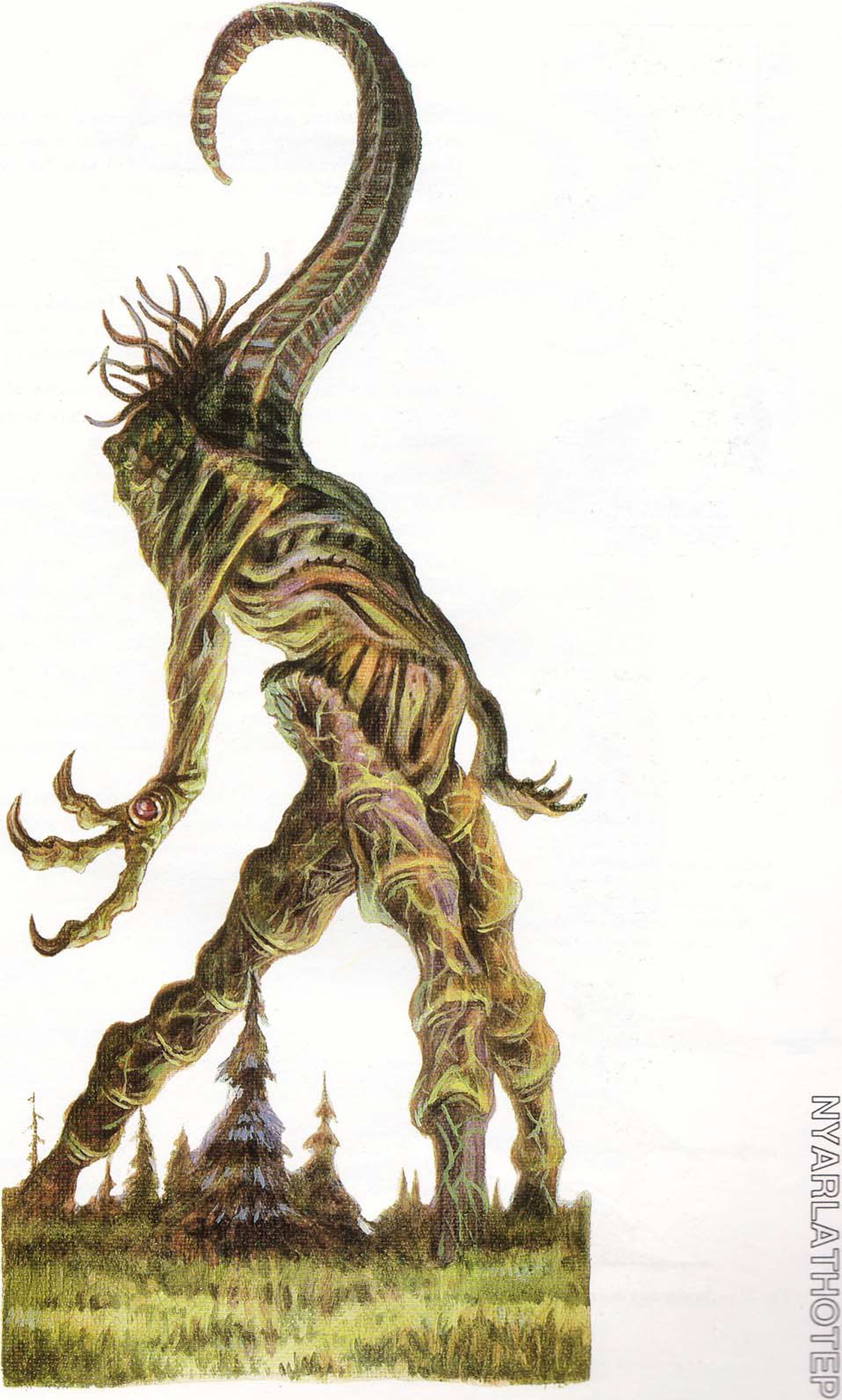

COMPARATIVE
HEIGHT CHART
Movement
Servitors normally progress by rolling. These sketches show that the being grips the substrate with its tentacles, pulling itself into position, after which it can roll along at moderate speeds.
“. . . something amorphously squatted far away from the light, piping noisomely on a flute . . . [amid] noxious flutterings in the foetid darkness . ... no warmth lay, but only the clamminess of death and corruption.”
J — H.P. Lovecraft.
Servitor OF THE OUTER GODS
A tentacled lump of flesh, a Servitor’s features remind one of a frog or octopus. The being almost always carries a musical instrument called a “flute” for lack of a better name, and is generally piping away at it.
Habitat: beyond space and time. Commonly found at the throne of Azathoth and at places inhabited by extremely powerful transcosmic entities.
Distribution: wherever it is sent. The Servitor is an extremely hardy entity which appears to be immune to vicissitudes of climate, temperature, atmosphere, and other environmental factors.
Life And Habits: a Servitor normally accompanies a much larger being. Sometimes a Servitor acts by itself to assist in organized cult worship of those beings which appear to be its masters.
While called Servitor, it is unclear exactly what relation the creature has with the larger being or beings it supposedly follows. Perhaps the species is parasitic or symbiotic, rather than attendant (Dannseys, 1978). If this is true, its high intelligence and occult aptitude probably lead it to foster the development and worship of its host being.
The Servitor is adept in the practice of occult science and this, added to its physical robustness, makes such a being extremely difficult to harm. A would-be collector should carefully prepare for all possible contingencies, take proper equipment, and keep more than one escape route handy.
Distinguishing Servitors of the Outer Gods —
-
♦ Chthonians are much larger and accompanied by chanting noises, rather than piping sounds;
-
♦ Cthulhu and his spawn are much larger and always greenish in color;

Fig. 22 — Servitor luck and roll.
-
♦ Flying Polyps can fly, and frequently are more or less invisible;
-
♦ Formless Spawn are black in color;
-
♦ Moon-Beasts do not extrude tentacles, except for their pinkish sensory organs, always found at the tip of their snouts;
-
♦ Shoggoths are constantly bubbling and forming and reforming eyes or other organs.
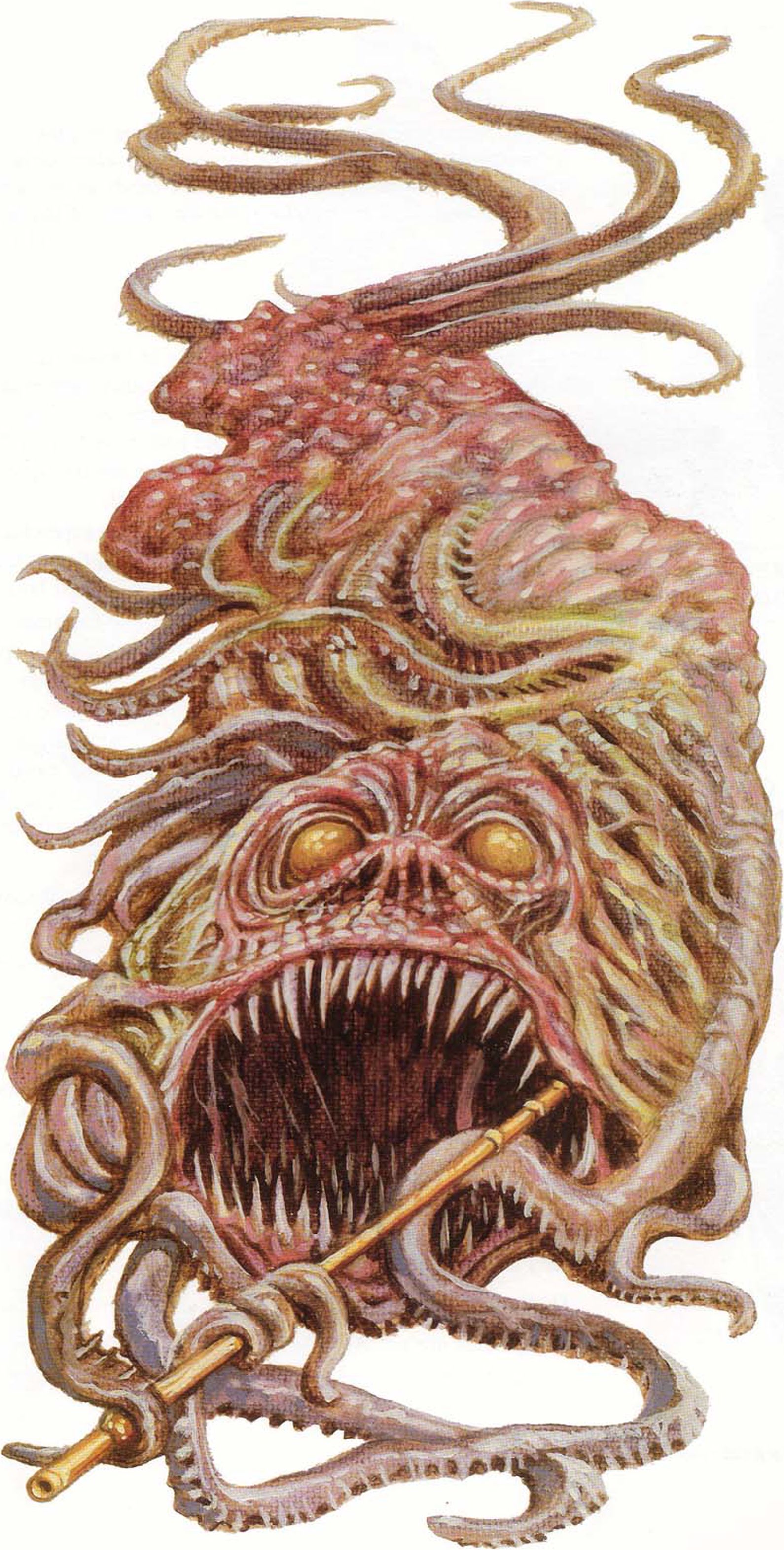
mJLDMBS
COMPARATIVE HEIGHT CHART
Offspring
The shell of the egg is turning transparent, indicating that it is near hatching. The young animal will receive little parental care, and must fend for itself within a few
Fig. 23 —Egg of a female Shantak.
“They were not any birds or bats known elsewhere on earth or in dreamland, for they were larger than elephants .... Carter knew that they must be the Shantak-birds of ill rumor . . . to whose wings still clung the rime and nitre of the nether pits.”
— H.P. Lovecraft.
Shantak
A Shantak is a huge scaly creature made of terrestrially-known matter. It shows many surprising similarities to Earthly vertebrates. It has elephantine size and bulk, two wings, a scaly integument, and two legs. It is long-necked and long-tailed. Old traditions call the Shantak “horse-headed,” and in fact the skulls have faintly equine proportions, though any resemblance is purely coincidental.
The Shantak thorax is largely filled with a supercharging mechanism which enriches the wing muscles in flight. Only in this way does the creature get enough energy to keep its vast bulk aloft.
The description above applies only to the Common Shantak. The little-known Lesser Shantak is much smaller and looks quite different, with a furry hide and prodigious claws on its forewings.
Every Shantak is panic-struck by the appearance of a Nightgaunt. Presumably both the Shantak and the Nightgaunt originated or once lived side-by-side in the same part of the universe, causing this instinct to develop. No objective reason for the Shantak’s fright has been found; on the face of it, a Shantak is much larger and stronger than any Nightgaunt.
Habitat: mountains and desert plateaus. The Shantak can traverse outer space, but does not normally spend much time there.
Distribution: this creature, like the Nightgaunt and Moon-Beast, often haunts the Dreamlands. It is also known on certain desolate worlds of our plane.
Life And Habits: a Shantak reproduces by laying eggs. Both sexes lay eggs, with or without mating. The egg of the male shantak has extremely interesting properties according to folklore, but not one has yet made its way to Earth. Miskatonic University’s School of Medieval Metaphysics maintains a large standing reward for such an egg.
Shantaks primarily feed on autotrophic organisms, such as plants. They can temporarily survive on animal life forms, but this is not their major sustenance.
Distinguishing Shantaks —
-
♦ Byakhee are much smaller and have four legs, not two;
-
♦ Hunting Horrors have no legs at all, presenting ophidian silhouettes.
-53-
54
the Shoggoth extends at least 20' feet
. multicellular protoplasmic masses capable of molding their tissues into all sorts of temporary organs under hypnotic influence . . . thereby forming ideal slaves to perform heavy work. These viscous masses were without doubt what Abdul Al-hazred whispered about as the ’Shoggoths’ in his frightful Necronomicon . . .
— H.P. Lovecraft.
COMPARATIVE HEIGHT CHART
Shoggoth
A Shoggoth is a huge, oozing, multi-cellular mass, typically black in color. As it needs or wills, it produces or dissolves temporary eyes, vocal apparatus, or other organs within its form. It commonly communicates by whistling and piping noises, imitating the speech of former masters, the Elder Things.
It can be enthralled by a trance resembling hypnosis, leaving it completely under the sway of the entrancer. The Shoggoth may not enjoy this experience, as testified by the great revolt against the Elder Things.
A Shoggoth typically attacks by engulfing a foe and sucking apart the victim. Its loathsome power and near-immunity to most types of physical attack give this creature a deservedly fearsome reputation.
Habitat: primarily undersea on Earth, though capable of living on land.
Distribution: the Shoggoth is not widely found, fortunately. Even Abdul Al-hazrad (properly, Abd Al-azrad) in his Necronomicon did not admit that any were found on Earth. Sadly he appears to have been quite wrong. These useful slaves are found on any planet ruled or once ruled by Elder Things; other intelligent species may also find Shoggoths of value.
Life And Habits: a Shoggoth reproduces by budding, and feeds on any organic matter it absorbs or engulfs. It can live almost anywhere, though on Earth the species primarily persists in the deep sea, where a few have been tamed by Deep Ones for mysterious schemes against humankind.
A Shoggoth is extremely tough: it is cold-resistant, not especially afraid of fire, nor is it flammable, unlike many fabled monsters in Hollywood movies. Deal with an aggressive Shoggoth by headlong flight.
Distinguishing Shoggoths —
-
♦ Azathoth does not reform eyes and other organs from its mass;
-
♦ Flying Polyps fly, and often become invisible;
-
♦ Formless Spawn are, overall, pitch-black and form characteristically vertebrate-like organs such as heads and legs from their body mass.
Free-Floating
The Shoggoth naturally assumes a spheroidal shape about 15’ in diameter.
COMPARATIVE
HEIGHT CHART
Budding
Note the swollen bud sprouting from Shub-Niggurath’s side. Eventually the mature bud splits off from its parent. The bud’s final shape and function can only be
Fig. 25 — Evidence of offspring.
“Evil. . . appears on every hand as a lurking and conquering adversary. . . [and the visible world is] a theatre of infinite tragedy and woe, with unseen half-existent influences hovering over it and through it, battling for supremacy and moulding the destinies of the hapless mortals who form its vain and selfdeluded population.”
— H.P. Lovecraft.
Shub-Niggurath
One of the Outer Gods, along with Nyarlathotep, Yog-Sothoth, and Azathoth, often Shub-Niggurath is referred to as the “Black Goat of the Woods With a Thousand Young.” Occasionally it is classified as female, but gender probably is meaningless to such an ehtity.
This enormous cloudy mass roils and festers, parts of the mist coalescing at times to form ropy tentacles, slime-dripping maws, or writhing hoof-tipped legs.
Shub-Niggurath’s common offspring are the infamous Dark Young, described earlier in this book. It gives birth to Dark Young spontaneously, possibly at will.
It has been known to spawn other creatures as well, usually after conjugation with another Outer God or lesser being. One such offspring exists in England, reportedly providing immortality to the inhabitant-worshipers of a small village named Goatswood.
Habitat: Shub-Niggurath appears where and when it wills, or where advanced hyper-geometry summons it.
Distribution: in common with most of the Outer Gods, it crosses both space and time, and thus can appear in multiple locations simultaneously. Shub-Niggurath probably is often present at the center of the universe, as one of the gigantic horrors slowly dancing and writhing before Azathoth.
Life And Habits: often Shub-Niggurath is referred to as female because it embodies a cancerous fecundity, spawning grotesque offspring with alarming ease and extravagance. This entity appears to have no major objective, at least on Earth, other than feeding and reproducing.
As a procreator in the Outer Gods pantheon, Shub-Niggurath may be more important than we think. At least one investigator (Choirs, 1986) links this entity with several species of amorphic beings who are prominent in our inner galaxy.
Distinguishing Shub-Niggurath —
-
♦ Azathoth has no visible mouths;
-
♦ Dark Young are much smaller and possess definite shapes;
-
♦ Yog-Sothoth appears as many separate bubbles, rather than as a single amorphous mass.
-57-
COMPARATIVE
HEIGHT CHART
Feeding Apparatus
The cross-section of a stomata shows a ridged, muscular proboscis and sucking-stomach just under the body surface. The teeth rasp into the victim’s integument. The branching tubes leading from the sucking-stomach distribute food liquids in the Star Vampire’s body. The purpose of the coiled gland at the base of the sucking-stomach is unknown: it may secrete digestive enzymes or a protective fluid.
Fig. 26 — Stomala cross-section.
“The one test of the really weird is simply this — whether or not there be excited in the reader a profound sense of dread, and of contact with unknown spheres and powers; a subtle attitude of awed listening, as if for the beating of black wings or the scratching of outside shapes and entities on the known universe’s utmost rim.” _
— H.P. Lovecraft.
Star Vampire
A Star Vampire is normally invisible. It often emits disconcerting laughter or grotesque titters. It becomes visible immediately after feeding, taking on the color of whatever liquid is being absorbed into its tissues. This predator can be sprayed or dusted with opaque materials, rendering it visible for an extended period of time (Blake, 1935).
A Star Vampire feeds only on liquid food. Its sucker-mouths and talons tear open the integument of a victim to reach the inner juices.
This vampire flies with no visible means of propulsion. It is obviously made of non-terrestrial matter, which doubtlessly assists it in remaining air- or space-borne.
Habitat: outer space. The species seems to live in between the stars, traveling to planetary surfaces to feed or when summoned by certain quasi-telepathic techniques (Blake, 1935).
Distribution: ubiquitous in our galactic arm.
Life and Habits: the internal structure of a Star Vampire is peculiar and loosely-grained. Astonishingly for an interstellar dweller, it feeds only on complex organic liquids. It is of roughly human intelligence, but no artifacts are associated with the Star Vampire, nor do we know whether or not it is social, nor how or if it reproduces.
It ingests its liquid food through many stomata, tiny suckermouths equipped with teeth and separate sucking-stomachs. The liquid then is assimilated throughout the creature’s form, rendering it temporarily visible. Within a varying length of time, less than a minute in the case of mammalian blood (Fallworth, 1936), the liquid metabolizes and the creature once more becomes transparent.
We do not know how the Star Vampire speedily traverses the great distance between its natural haunts and solar system food sources. Some results indicate use of sub-dimensional tunnels (Dannseys, 1988). No evidence of a hune has been found (Ratsegg, 1988), but the properties of that organ are poorly understood.
As with other such beings, the Star Vampire is unstudied in its natural habitat, for lack of proper extra-solar research facilities.
Distinguishing Star Vampires —
-
♦ Flying Polyps emit whistling shrieks rather than tittering sounds;
-
♦ Fungi From Yuggoth are always visible to the naked eye.
-59-
COMPARATIVE
HEIGHT CHART
Fig. 27 — Example of damaged tissue.
Touching Yog-Sothoth
Yog-Sothoth’s substance has seriously damaged this man’s arm. Blisters, dessicated tissue, and exposed bones typically result from such contact.
“The Old Ones were, the Old Ones are, and the Old Ones shall be. Not in the spaces we know, but between them, they walk serene and primal, undimensioned and to us unseen. Yog-Sothoth knows the gate. Yog-Sothoth is the gate. Yog-Sothoth is the key and guardian of the gate. Past, present, future, all are one in Yog-Sothoth. He knows where the Old Ones broke through of old, and where They shall break through again. He knows where They have trod earth’s fields, and where They still tread them, and why no one can behold Them as They tread. . . . As a foulness shall ye know Them. Their hand is at your throats, yet ye see Them not; and Their habitation is even one with your guarded threshold.”
— H.P. Lovecraft.
Y og-Sothoth
In our dimensions the transcosmic entity known as Yog-Sothoth appears as a conglomeration of iridescent globes. These globes undergo continuous motion and reorganization, shifting, flowing into one another, and breaking up to coalesce again. The globes are not always attached to one another, and may spread over quite a large area.
Even primitively-equipped investigators can contact Yog-Sothoth. However, this entity is notoriously dangerous, and non-specialists should avoid contact. Prolonged or indeterminate contact with Yog-Sothoth has been demonstrated to be deleterious to the local continuum (Fallworth, 1928).
Yog-Sothoth is one of the cryptic Old Ones, whose contact with humanity has fortunately been minimal of late. It is unknown whether Yog-Sothoth is a representative example of those beings. Unfortunately scant data suggests that contact with any Old One is most inadvisable (c/. Mustoll 1984, 1987).
Habitat: Yog-Sothoth primarily inhabits an interstitial zone between various dimensions and planes, rendering it coterminous with all time and space.
Distribution: Yog-Sothoth can be encountered anywhere in this universe.
Life And Habits: even in ancient texts, Yog-Sothoth is the Opener of the Way and the provider of strange wisdom. This attribute was confirmed by Hutchinson (1864); most hard metaphysicians still routinely turn to Yog-Sothoth as the key intermediary for reconnaissance and exploration of otherwise inaccessible interstellar bodies and dimensions.
Our knowledge of Yog-Sothoth and the other Old Ones is at present so minimal that printed speculation concerning origin, powers, rank, or significance would be disinformational.
Distinguishing Yog-Sothoth —
♦ Shub-Niggurath is a vague mass, not a series of discrete spheroids.
Nightgaunt
Formless Spawn
Dim. Shambier
Star Vampire Ghast
Elder Thing
Nyarlathotep Spawn Or Cthulhu (tint) Servitor
Hound ofTindalos
Chthonian
Great Race
Azathoth, 1st stage
Shoggoth
Hunting Horror
Shantak
Flying Polyp
Byakhee
Fungi From Yuggoth
Relative Sizes
Ithaqua
Sandy Petersen / Tom Sullivan / Lynn Willis
Dhole extends another 130
Moon-Beast Deep One
Dark Young
Yog-Sothoth Shub-Niggurath extends 20 inches at this scale
RECOMMENDED READING
from Arkham House Publishers —
Lovecraft, H.P. 1963. The Dunwich Horror and Others. Corrected 6th printing.
— . 1964. At the Mountains of Madness and Other Novels. Corrected 5th printing.
— . 1965. Dagon and Other Macabre Tales.
Corrected 5th printing.
— . 1970. The Horror in the Museum and Other Revisions.
— and Derleth, August. 1974. The Watchers Out of Time and Others.
from Chaosium Inc. —
Petersen, Sandy. 1986. Call of Cthulhu: Fantasy Roleplaying in the Worlds ofH. P. Lovecraft. 3rd edition. Lynn Willis, ed.
Various authors additional material.
supplements to the game:
Barton, W.A.; Hamblin, W.; & Hargrave, D.
1984. Curse of the Chthonians. Sandy Petersen, ed.
Barton, W.A. 1986. Cthulhu by Gaslight. S.
Petersen and L. Willis, eds.
Costello, M.J., with Willis, L. 1985. Alone Against the Dark.
DiTillio, L., with Willis, L. 1984. Masks of Nyarlathotep.
Herber, K. 1984. The Fungi From Yuggoth.
S. Petersen, ed.
— . 1984. Trail ofTsathogghua [sic], S. Petersen, ed.
— . 1986. Spawn of Azathoth. L. Willis and S. Petersen, eds.
Petersen, S., and Willis, L., eds. 1982.
Shadows of Yog-Sothoth.
Petersen, S., and Willis, L., eds. 1983. The Asylum and Other Tales.
Petersen, S., and Willis, L., eds. 1985.
Fragments of Fear.
Petersen, S., and Kahn, S., eds. 1986. Terror From the Stars.
Petersen, S., and Willis, L., eds. 1987. Terror Australis.
Petersen, S., and Willis, L., eds. 1988.
Cthulhu Now!
Petersen, S.; Robson, K. L.; Herber, K.; and others. 1986. H.P. Lovecraft's Dreamlands. L. Willis, ed.
Petersen, S., and Sullivan, T. 1988.
Petersen’s Field Guide to Cthulhu Monsters.
L. Willis, ed.
Rahman, G. 1985. Alone Against the Wendigo. L. Willis, ed.
from other publishers —
Barlowe, Wayne Douglas, and Summers, Ian. 1979. Barlowe's Guide To Extra-Terrestrials. First edition. New York: Workman Publishing.
Cottam, Seth Jowell. 1967. A Conjectural Grammar. New York: Houghton Mifflin.
Genn, Harlan M. 1986. Investigators of the Beyond. New York: Random House.
Nobles, Samantha. 1983. Adventures in the Field. New York: Crowell Publishers.
Treer, Tamlan. 1984. A Preternatural Bestiary. 6 vols. New York: Harper & Row.
BIBLIOGRAPHY
Fallworth Festschrift — Isinwyll, L.N., ed. Recent Investigations: A Festschrift Honoring E.C. Fallworth: Fifty Years of Scholarship.
Arkham, Massachusetts: Miskatonic University Press, 1987.
Billington, A. P. 1945. “Growth-Rate Delays and Timing in Manifestations of Azathoth,” Medieval Metaphysics Journal 38:314-336.
Blake, R. 1935. “Seven Solutions to Invisibility,” Symposia Hypermetaphysica 33:111-143.
Choirs, Anne Scoa. 1978. “A Survey of Pseudoplasmic Super-Entities Common to Population II Stars,” Symposia Hypermetaphysica 84:334-380.
Dannseys, Peter. 1971. “Disturbing Irregularities in Lunar Photographic Files.” Master’s thesis, Provo State College.
— . 1978. “Reassessing Anomalous Servitor Behavior,” Medieval Metaphysics Journal 71:280-311
— . 1981. “Dhole Dispersal via Interdimensional Dreamland Connections,” Annals of the Innsmouth Society 114:114-131.
— . 1983. “Asterisms and Azathoth,” Proceedings of the Society of North American Astrographers 14:27-31.
— . 1986. A Natural History of the Ghoul. New York: Harvard University Press.
— . 1987. “Selected Hyper-Geometrical Principles as Illustrated by the So-Called ’Hunting Honor,’ ” Fallworth Festschrift, 189-207.
— . 1987 “Early Research Results from the N’Kai Excavations,” Publications of the Arkham Biophysical Institute, 40:21-25.
— . 1988. “Tracking Symmetrical Graviton Repressions,” Annals of the Innsmouth Society 121:44-46.
d’Erlette. 1959. “The Shuttered Room:
Longevity and Resorption in Branchanthropus,” Annals of the Innsmouth Society 92:257-289.
Fall worth, E.C. 1922. Moon-Beasts: Merchants of the Dreamlands. Providence, Rhode Island: Brown University Press.
— . 1927. Fifi: the Reclamation of a Ghoul. Arkham, Massachusetts: Miskatonic University Press.
— . 1928. Wilbur Whateley, 1913-1928.
Arkham, Massachusetts: Miskatonic University Press.
— . 1936. “Nutrition and Opacity in Interstellar Bdelloids” Medieval Metaphysics Journal 29:38-44.
Gillman, W. Duin. 1984. “Ghoul Reproduction in the Northeastern United States,” Proceedings of the International Metaphysics Society 42:41-59.
— . 1986. “Negative Phototropism and the ’Solar Censor’ Problem,” Proceedings of the International Metaphysics Society 44:220-281.
Hike, Herbert. 1983. A Preliminary Celaeno Catalog. Ann Arbor, Michigan: University of Michigan Press.
—. 1983. “A New Hound of Tindalos Chronology,” Symposia Hypermetaphysica 81:22-48.
Hutchinson, Edward. 1864. The Opener of the Way. Liverpool, England: Buzrael Press.
Isinwyll, L.N. 1981. “A New Family Tree: Dark Young and Human Dreams,” Medieval Metaphysics Journal 74:55-89.
— . 1985. “Cladistic Incongruities in Gyaa-Yothn,” Abstracta Bestialis 91:41-43.
— . 1986. “Recorded Incidence of Dark Young on Earth," Proceedings of the International Metaphysics Society 44:180-219.
— . 1987. “Perception in Forty-One Investigators of the Bizarre,” Fallworth Festschrift, 122-143.
— . 1987. The Shadow in the Wood: A Description and Natural History of the Dark Young of Shub-Niggurath. New York: Oxford University Press.
Kylton, Dana C. 1979. “Is There a South Edge to the Dreamlands?” Symposia Hypermetaphysica (Tipped-in
map after p. 256.)
Larkhan, Eric K. 1985. “Theorems from Matrix Mechanics Explicate N-Dimensional Beings.” Unpublished paper presented before the Histos Fellows of Mathematics, Miskatonic U., April 11.
Marsh, S. Robert. 1980. “Chthonian Embryology and Larval Development,” Annals of the Innsmouth Society, 113:7-89.
Moriarty, James. 1872. The Dynamics of an Asteroid. No press or place noted.
Mustoll, Ivan. 1984. “Emergency Procedures During Controlled Obsession of Yog-Sothoth,” Annals of the Innsmouth Society 82:317-324
— . 1985. “An Analysis of Divergent Musculature and Ennervation in Gyaa-Yothn,” Typological Journal 5:34-47.
—. 1987. “ ’The Way and the Gate’ to the Lesser Moons of Jupiter,” Fallworth Festschrift, 150-156.
Peaslee, Wingate. 1936. The Shadow Out of Time. Philadelphia, Pennsylvania: Golden Goblin Press.
Ratsegg, F. Ford. 1988. “Exploring the Outer Alpha Centauri System.” Unpublished NASA document 88.3.21/889912.
Varson, Michael. 1988. “A Telestitial Network? Asymmetrical Hilbert Spaces Detected,” Astrography News, October 17, 11-14.
Wasling, Noah. 1982. “Defeating the Hound of Tindalos,” Proceedings of the International Metaphysics Society 40:101-110.
— . 1984. “A Preliminary Survey of Formless Spawn Crustal Zones,” Sons of Dunwich Quarterly 160:21-38.
Wilbham, Ian Mill. 1988. “Annual Dimensional Shambier Appearances, 1970-1985,” Abstracta Bestialis 94:8-14.
N.B. —The Preternatural Clearing House, Arkham, Massachusetts, has since 1980 maintained a registry and information exchange of preternatural sightings in North America.
Weird shapes in the park? Odd rumbling noises in the basement? When you need to know what you’re encountering, you need to know it fast — don’t leave home without the Field Guide!
CHAOSIUM PUBLICATION 5105
-
• Accurate and Complete ■
-
• Over Two Dozen Often-Met Creatures ■
-
• Quick-Reference Monster ID Key
-
• 27 Evocative Full-Page Paintings I
-
• 50+ Illustrations and Silhouettes
-
• Uniform Presentation of Data
-
• Special Size Comparison Charts
-
• Habitat, Distribution, and Life Cycle Notes
-
• How to Distinguish Similar-Seeming Entities
-
• Latest Hyper-Geometric Scholarship
-
• Specialized Observer Warnings as Needed
-
• Full Bibliography
-
• Faithful to Lovecraft
Paintings and Descriptions From the Cthulhu Mythos As Created by H.P. Lovecraft, With Augmentations for Today
S. PETERSEN’S FIELD GUIDE
TO Cthulhu Monsters
Selected Pronunciations
Azathoth — AZ-uh-thoth Byakhee — B’YAHK-hee Chthonlan — kuh-THOEN-ee-un Cthulhu — kuh-THOO-loo Dhole — DOEL
Ithaqua — ITH-uh-kwah Nyarlathotep — NIE-ar-LATH-oe-tep Shantak — SHAN-tak
Shoggoth — SHOW-goth Shub-Niggurath — SHUB-NIG-ger-ath Tindalos — TIN-dahl-ose
Yog-Sothoth — YAHG-SOE-thoth
A Field Observer’s Handbook Of Preternatural Entities

